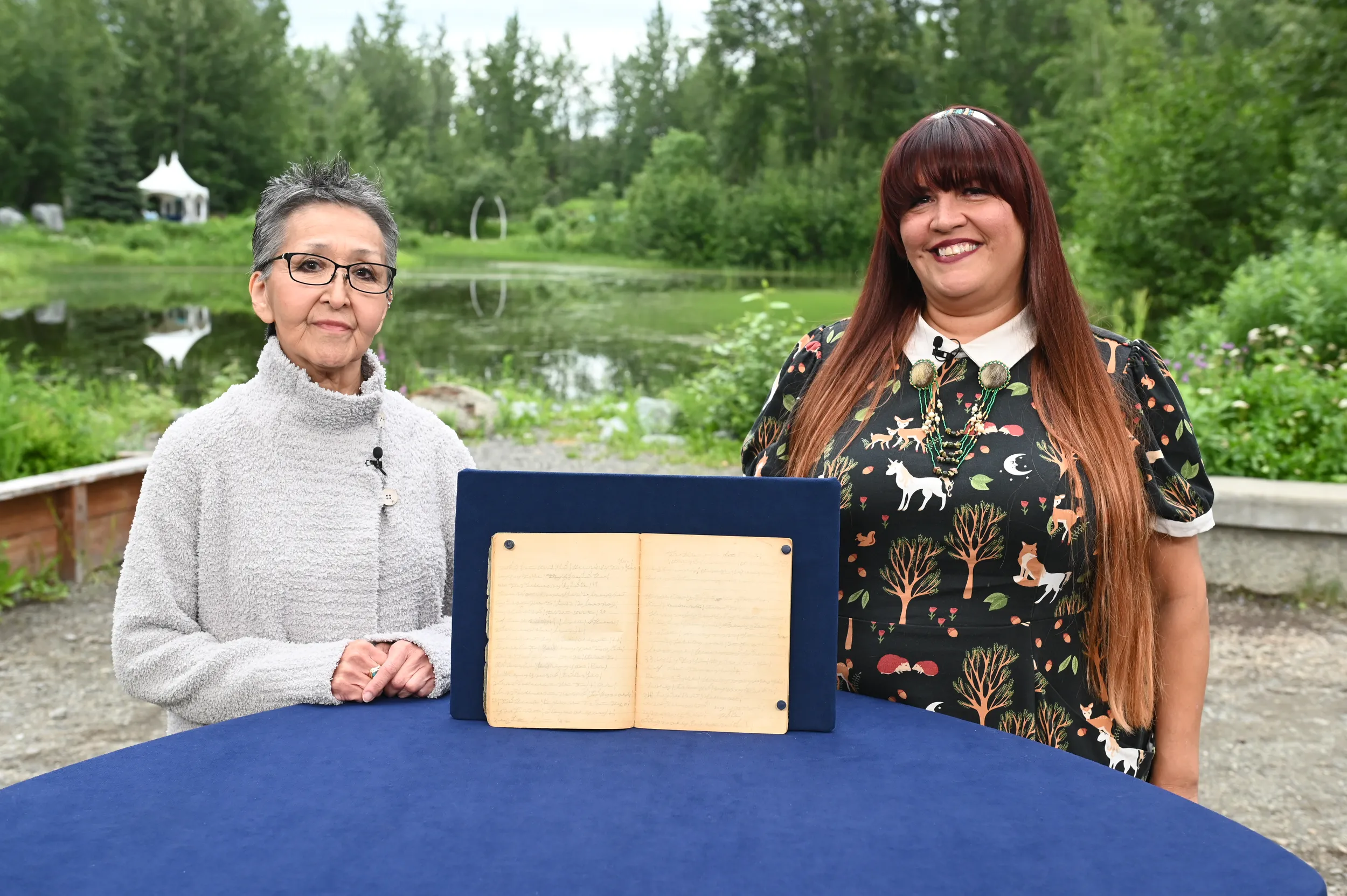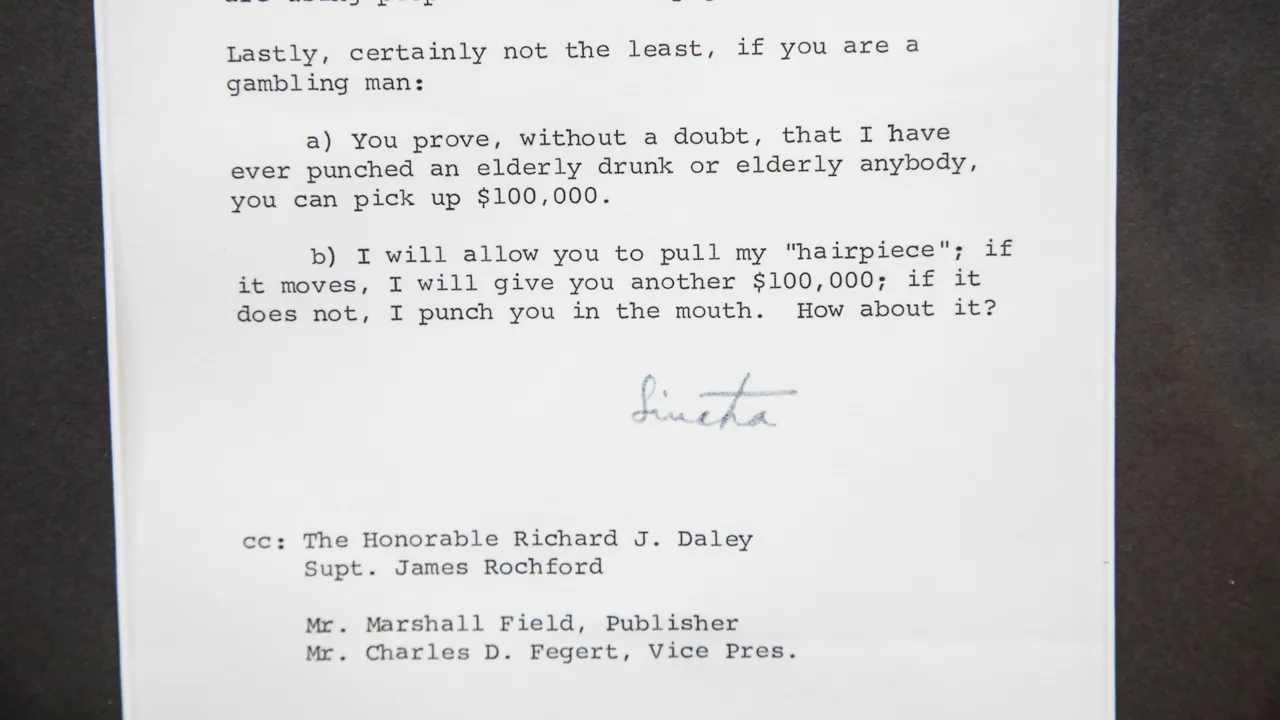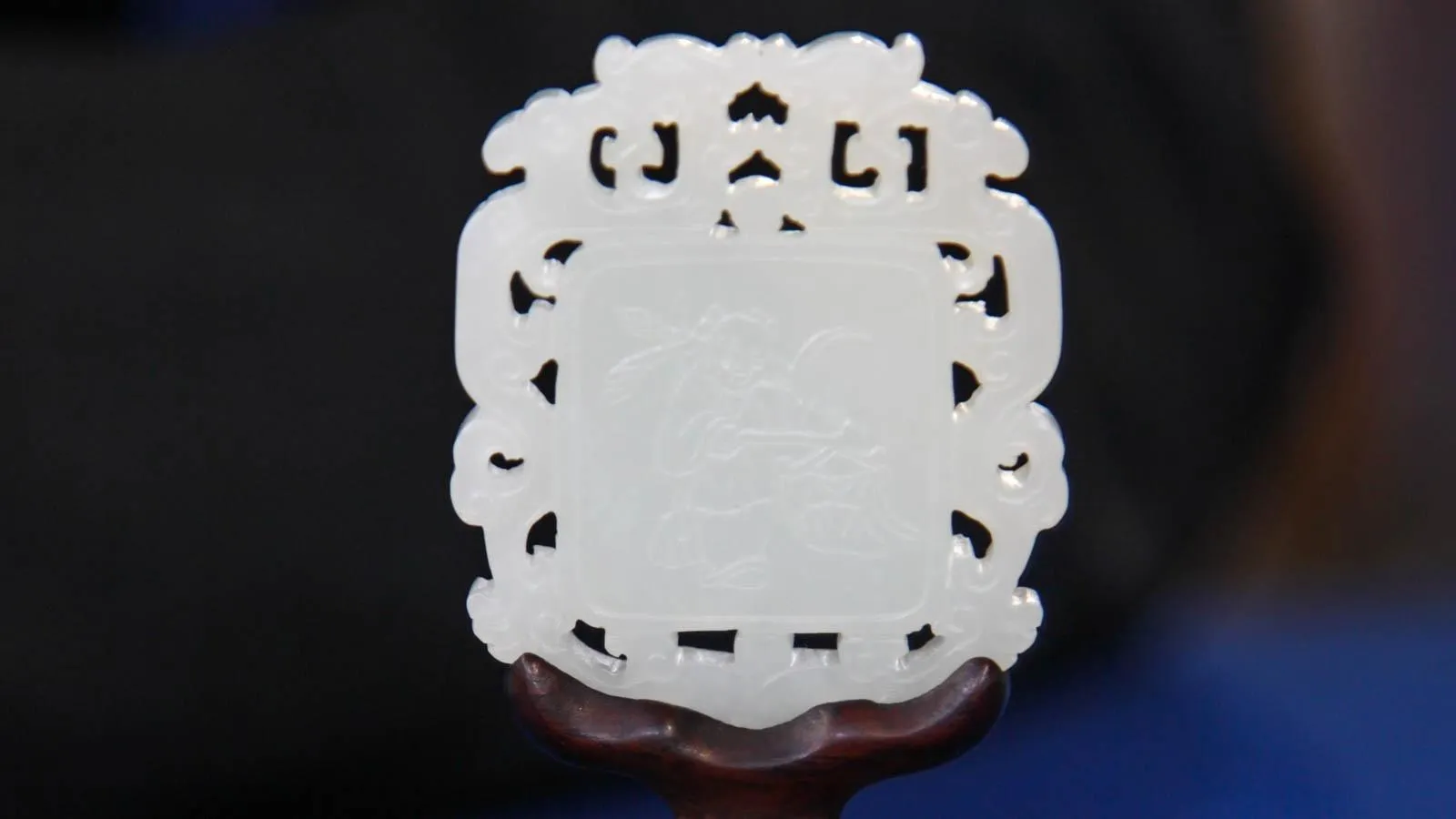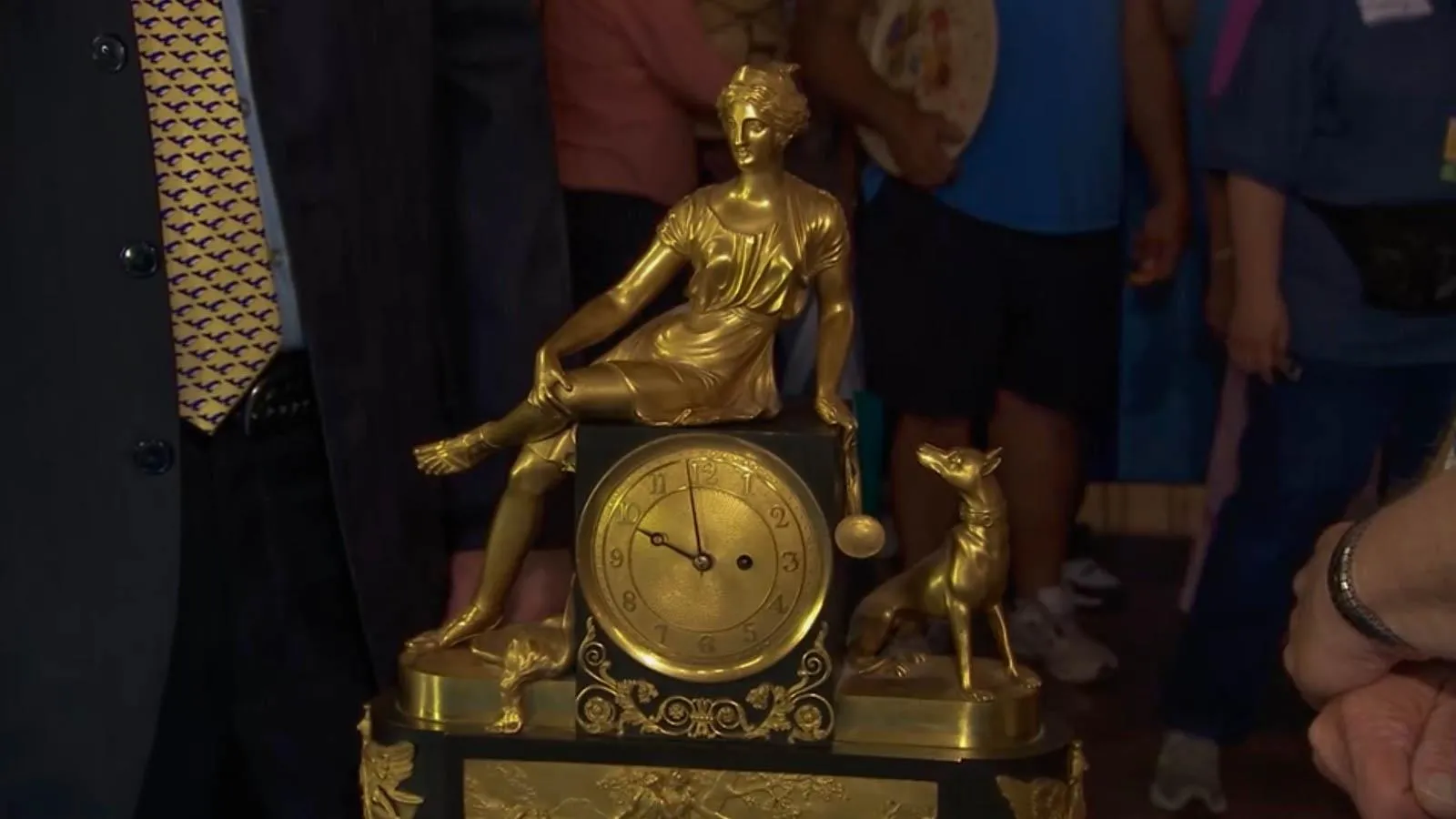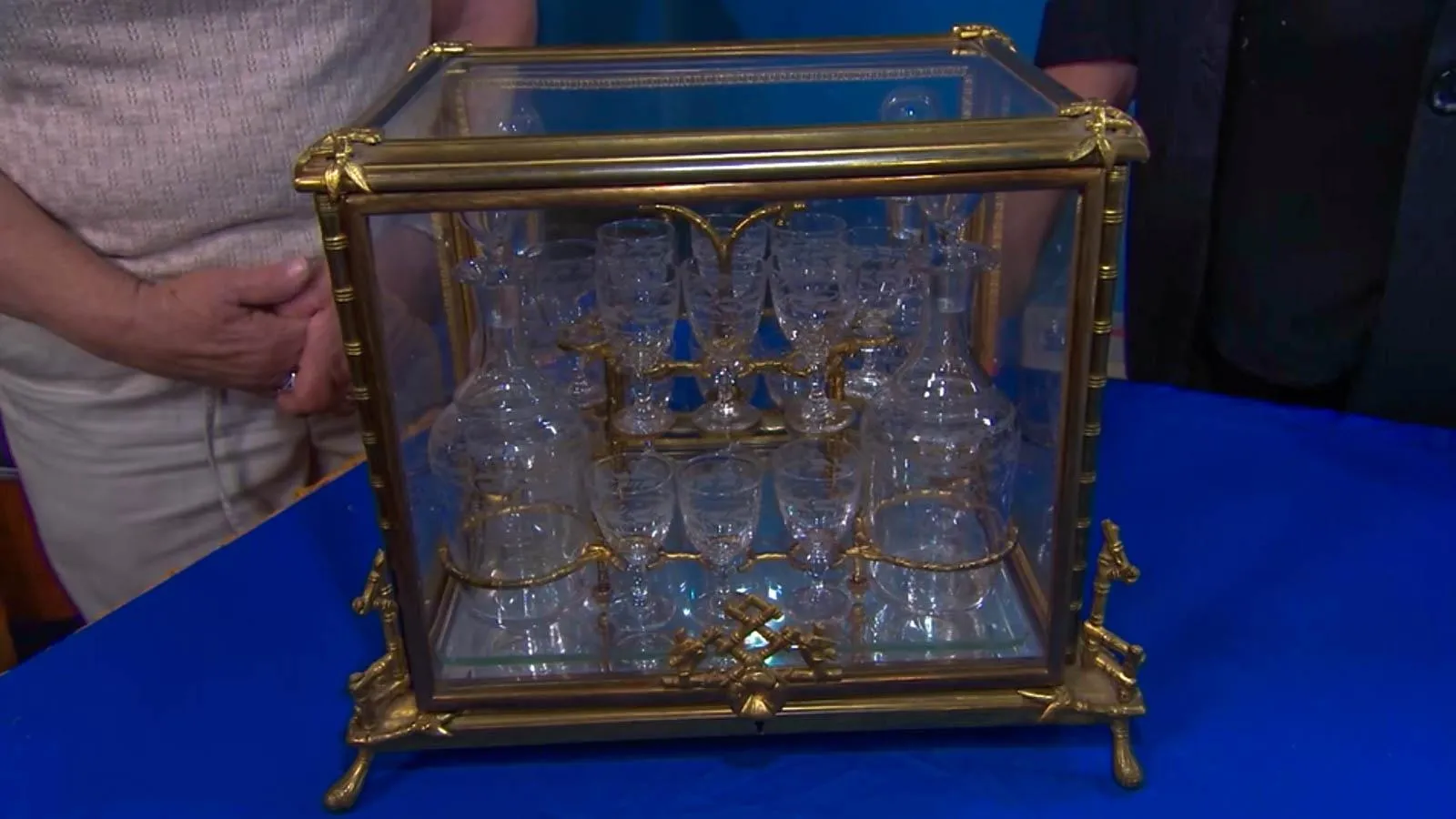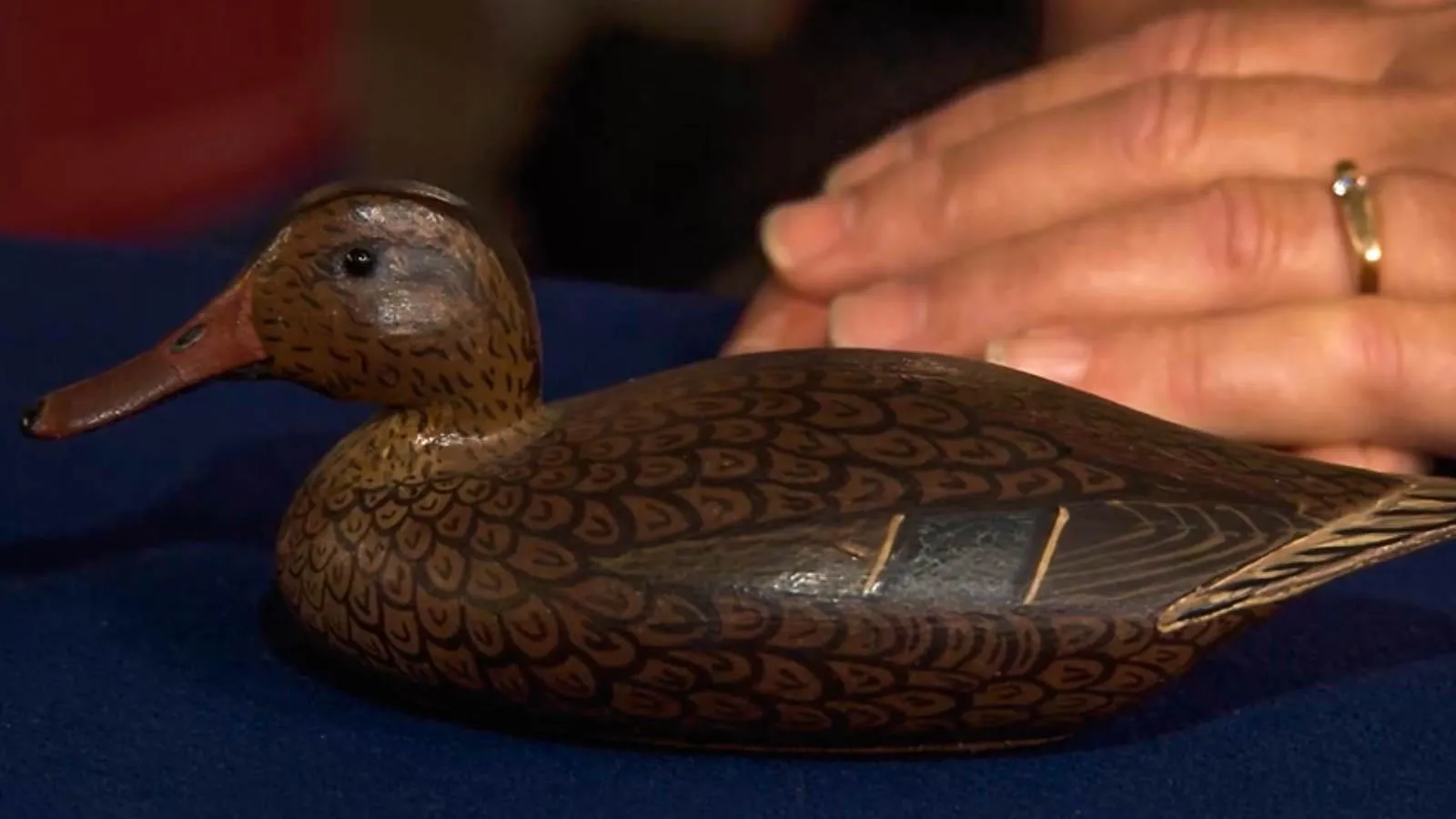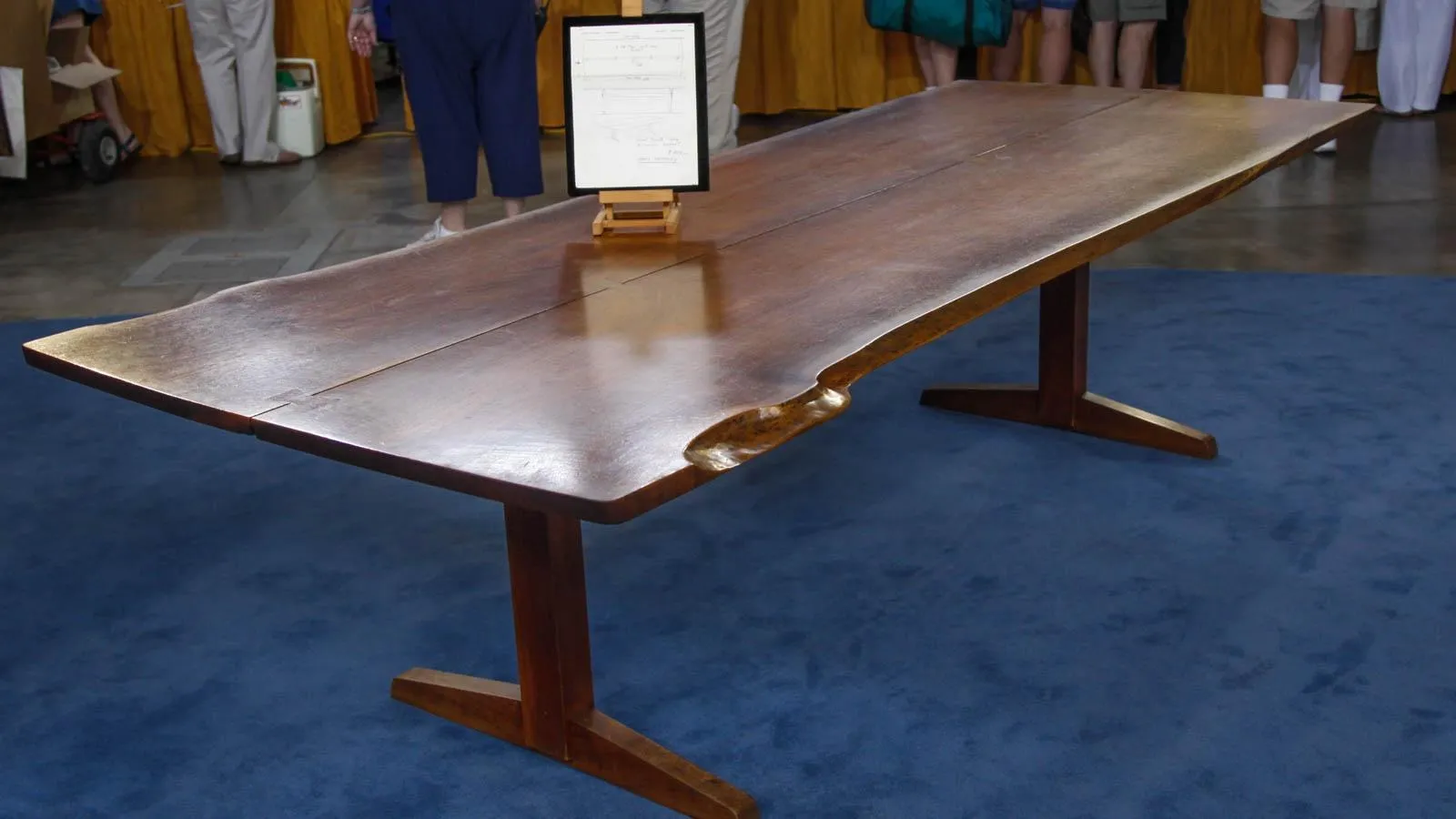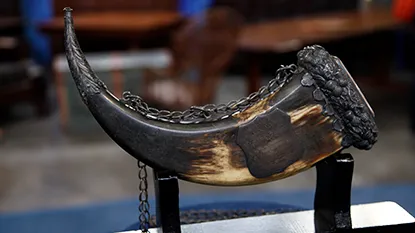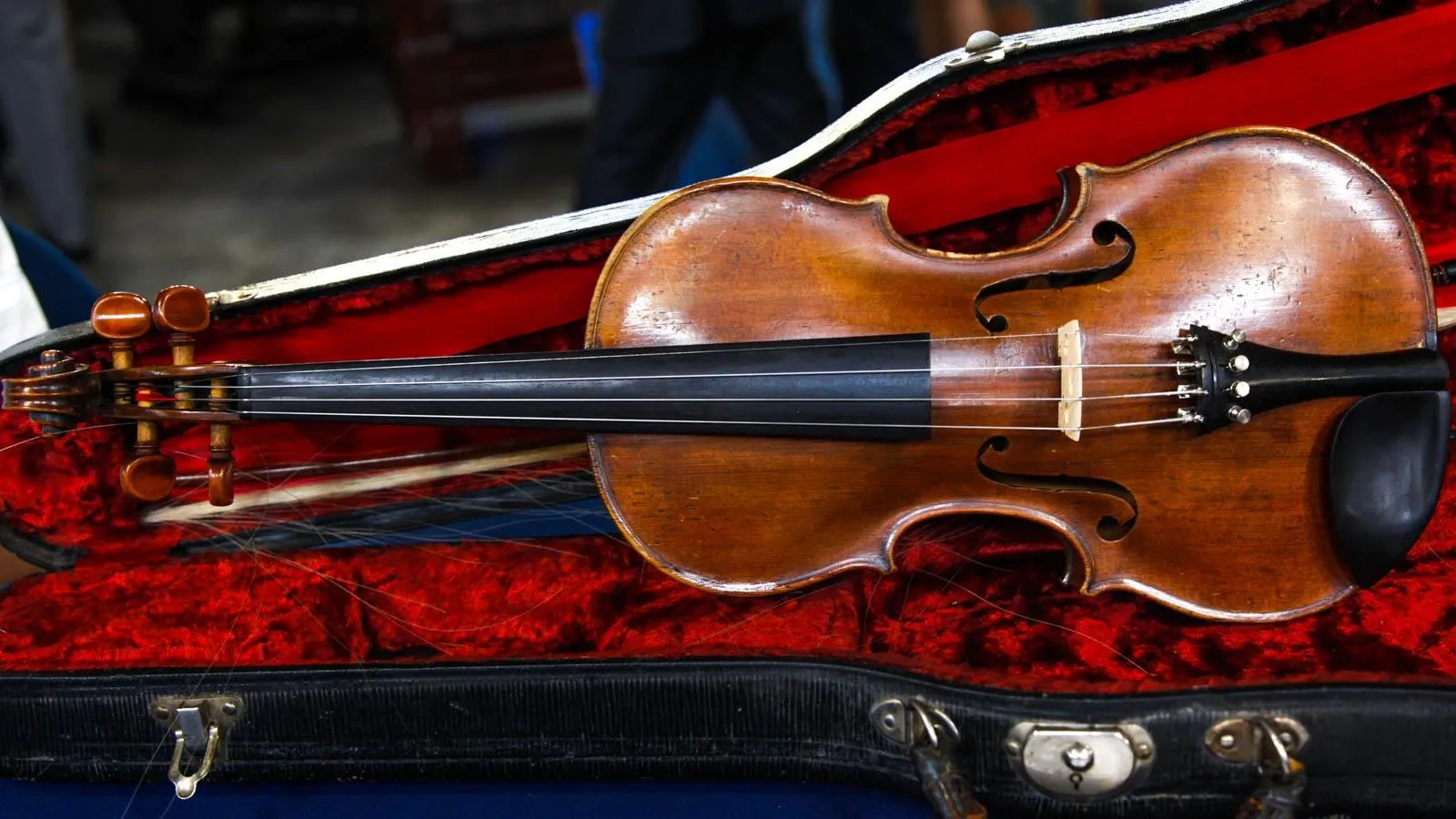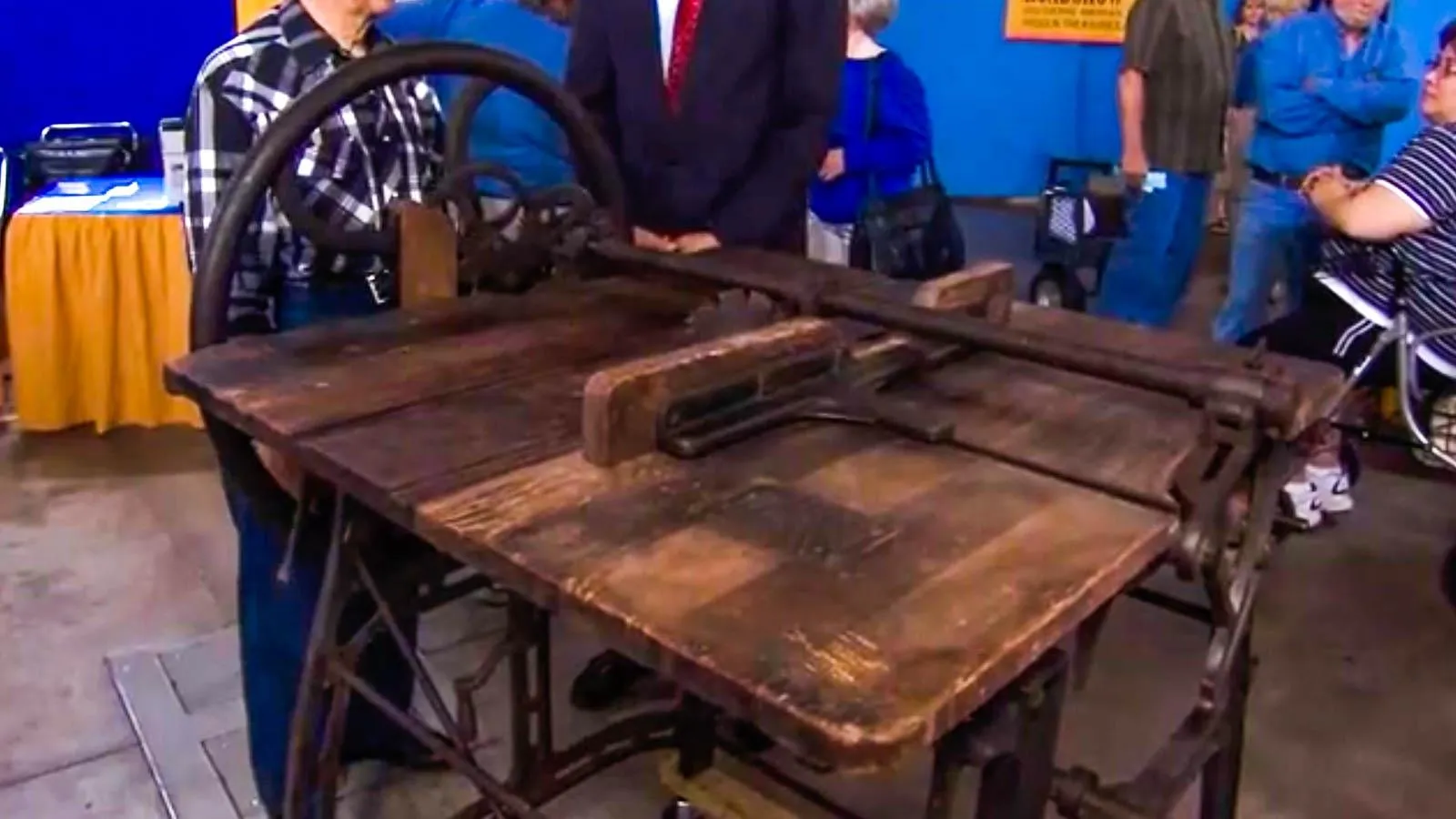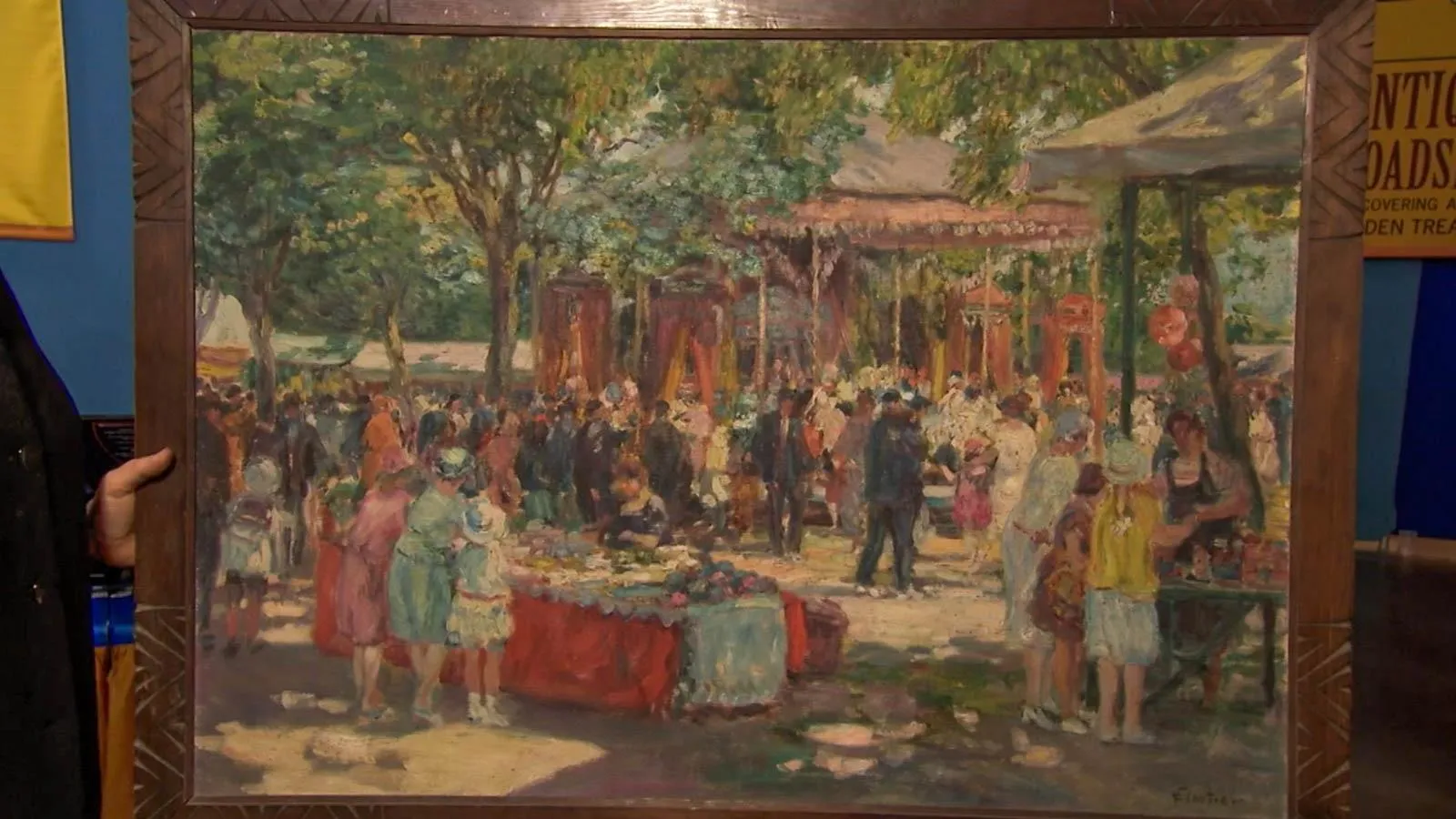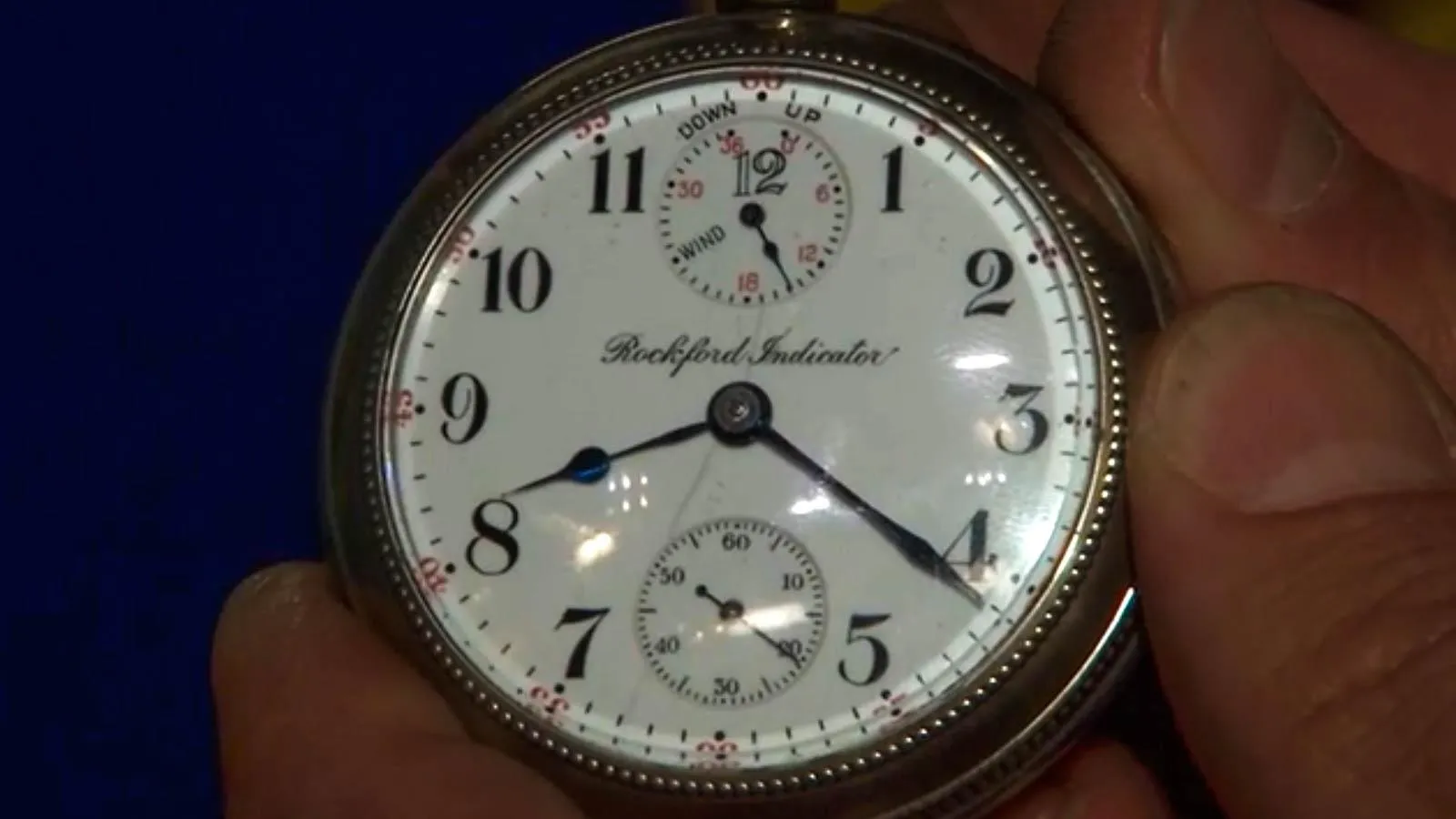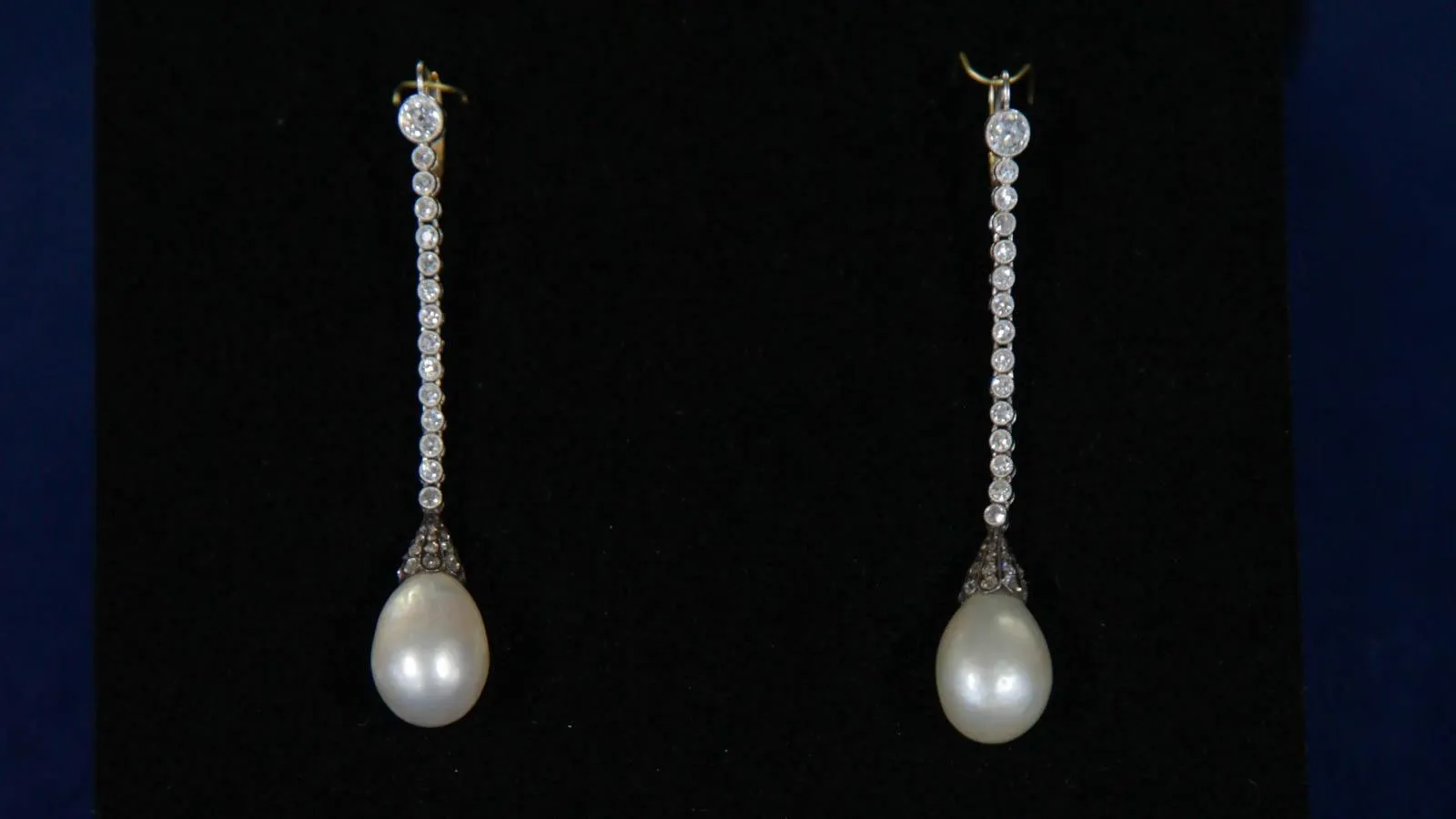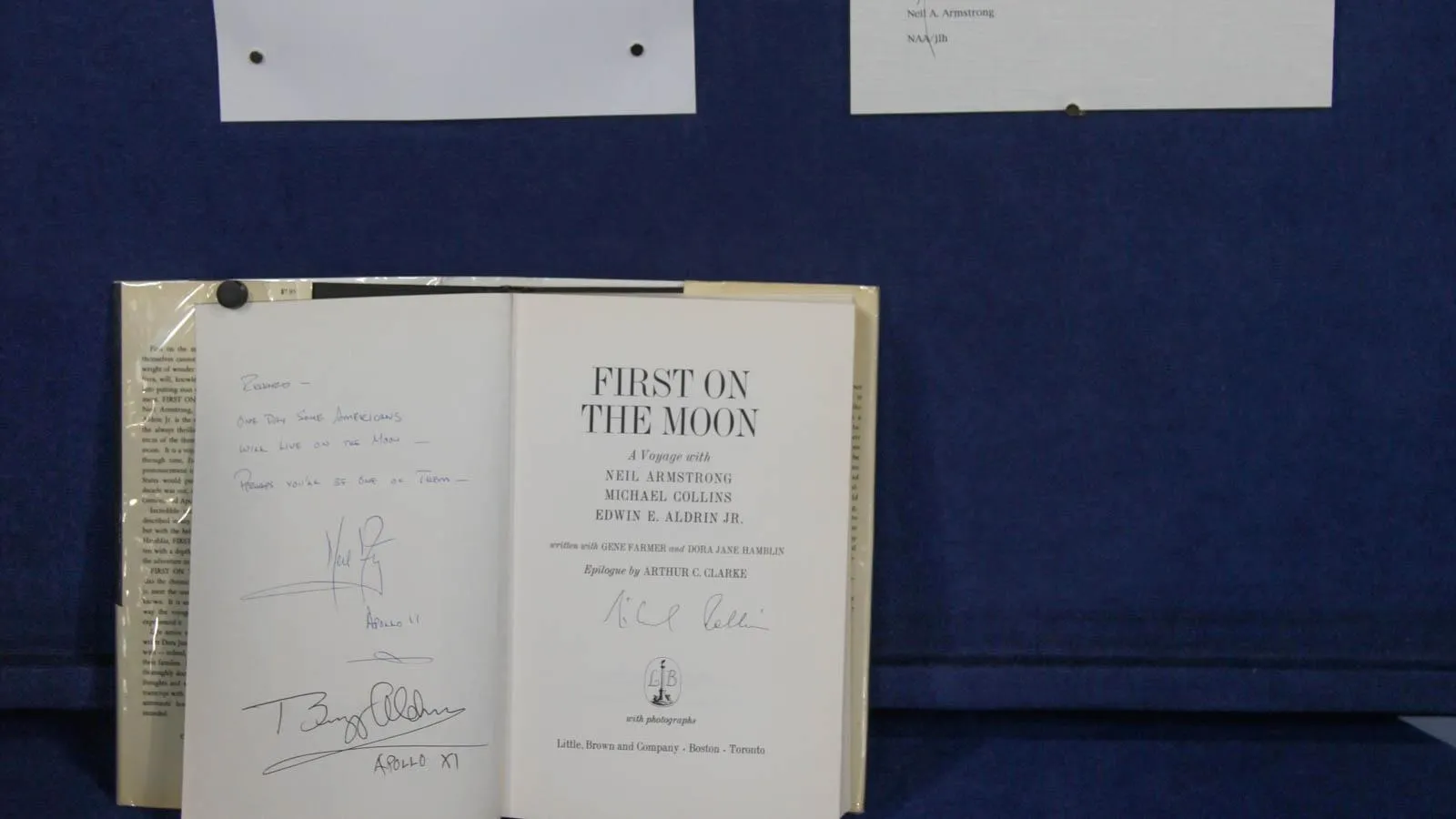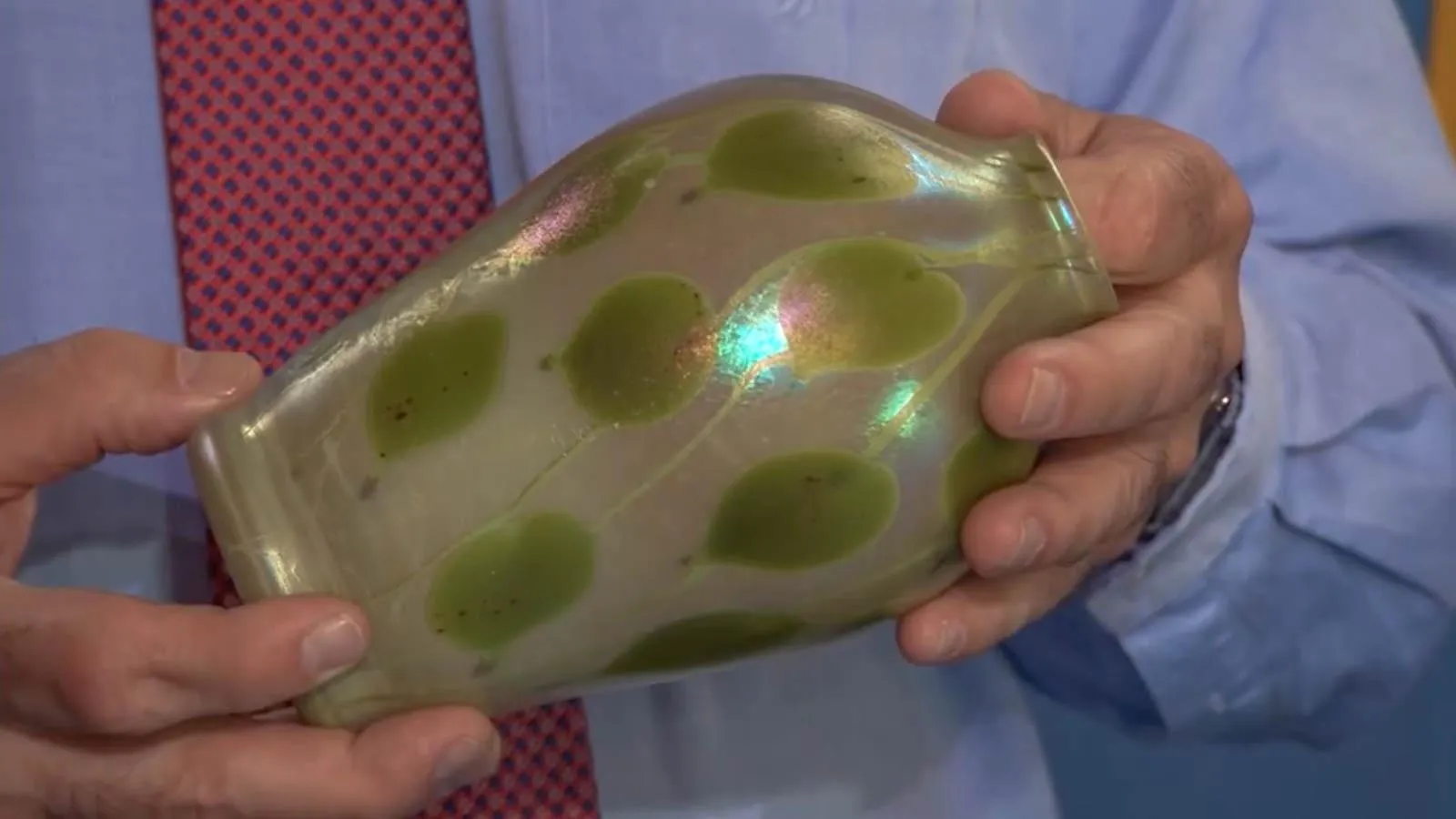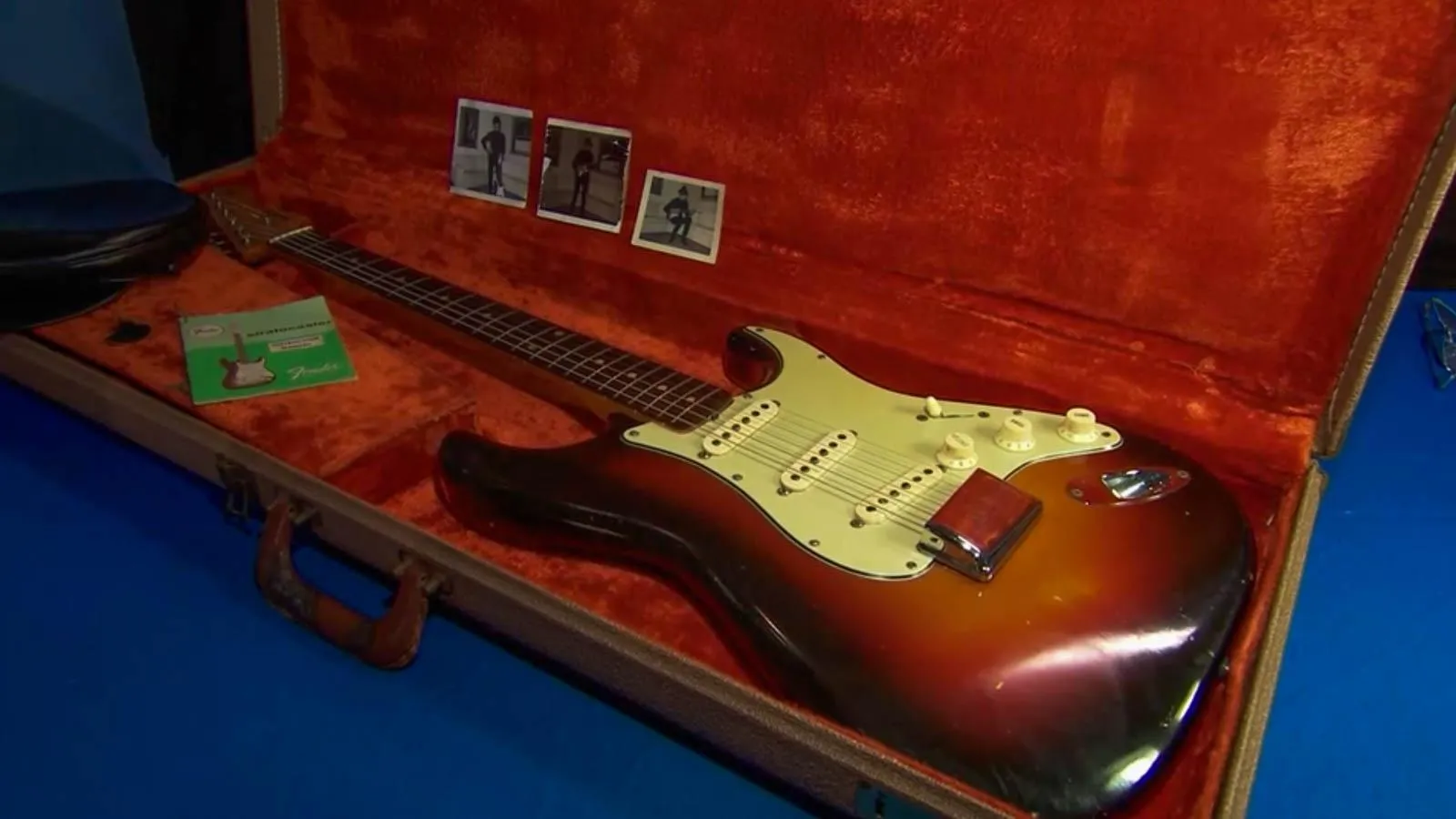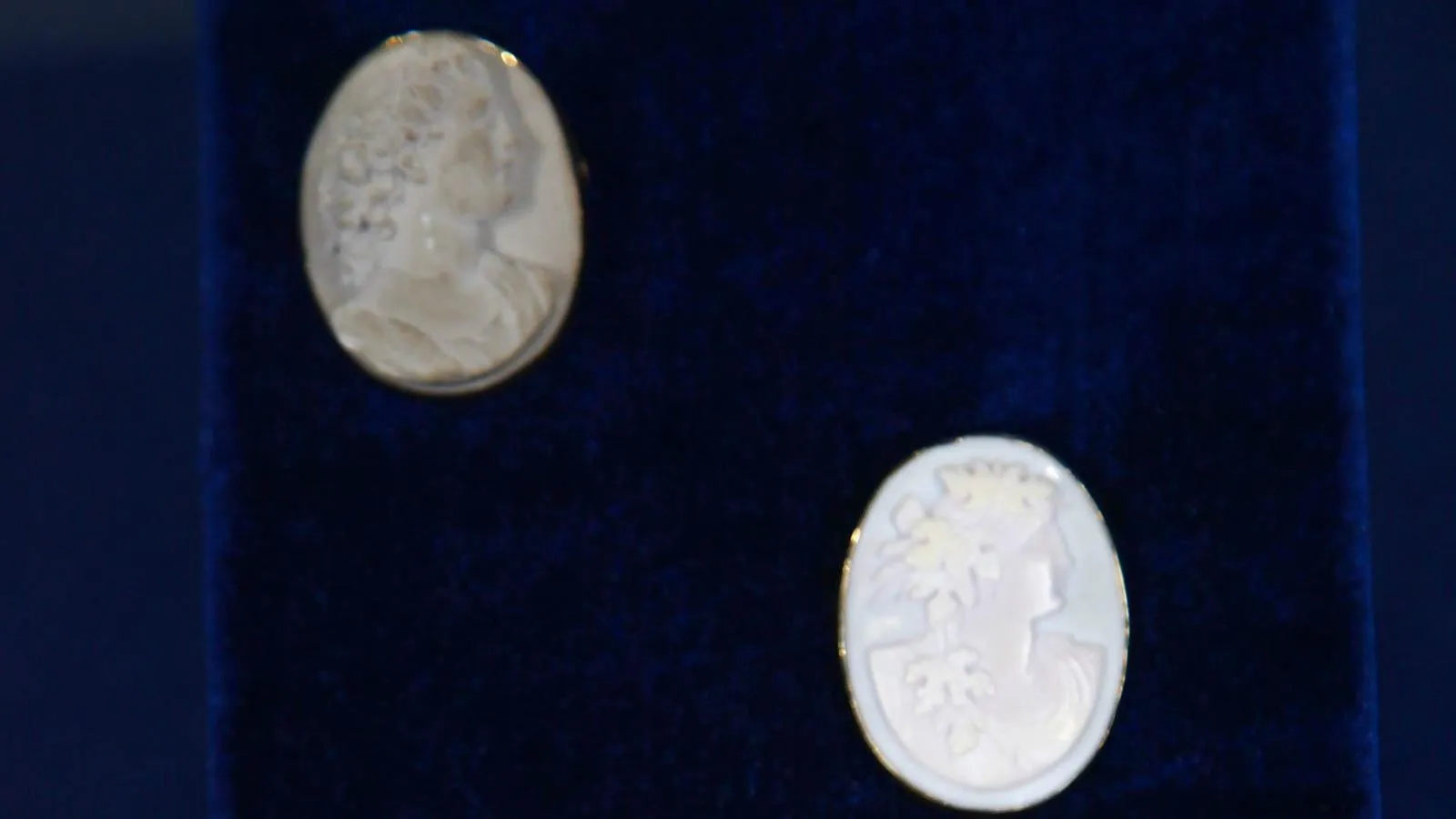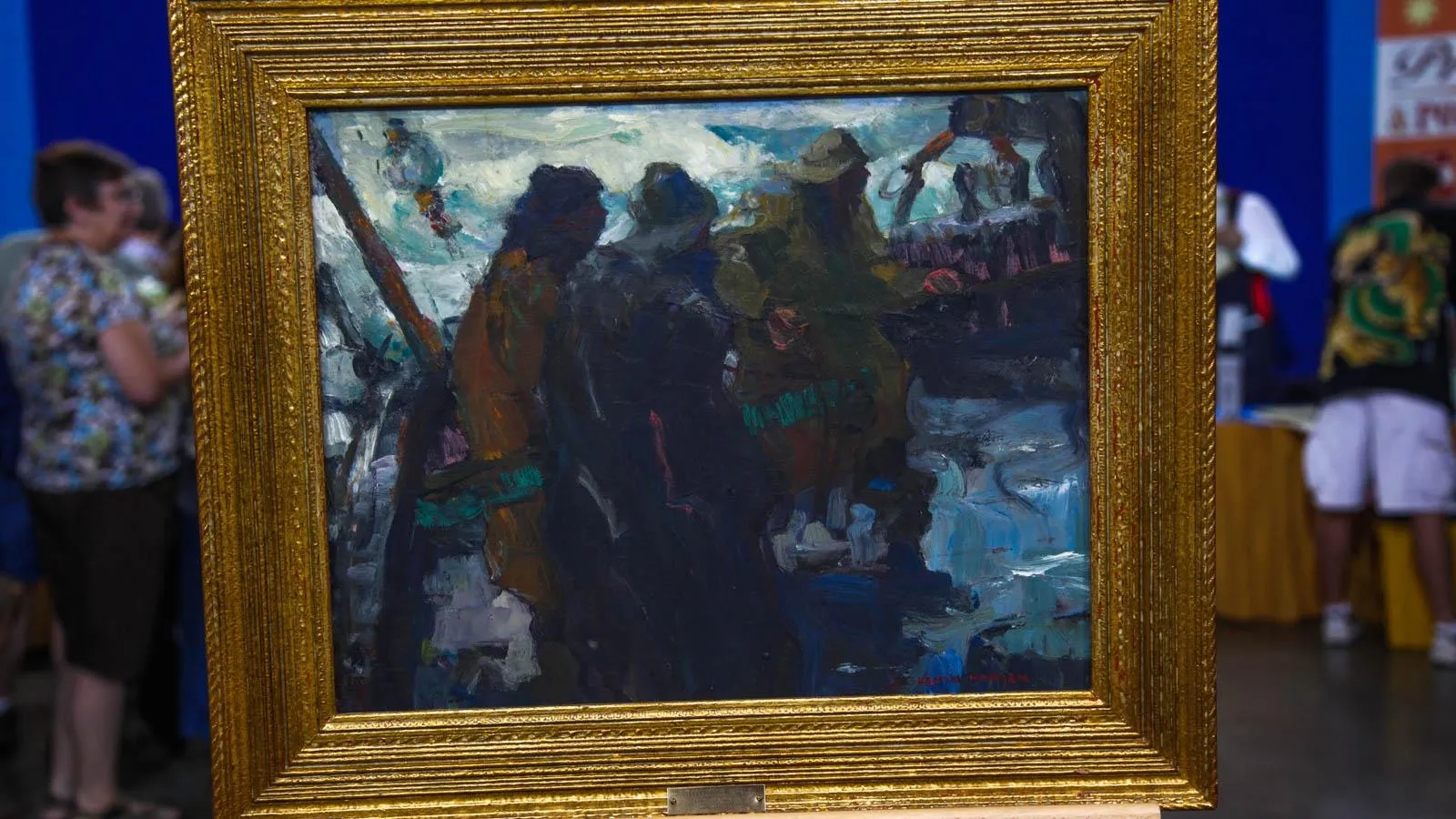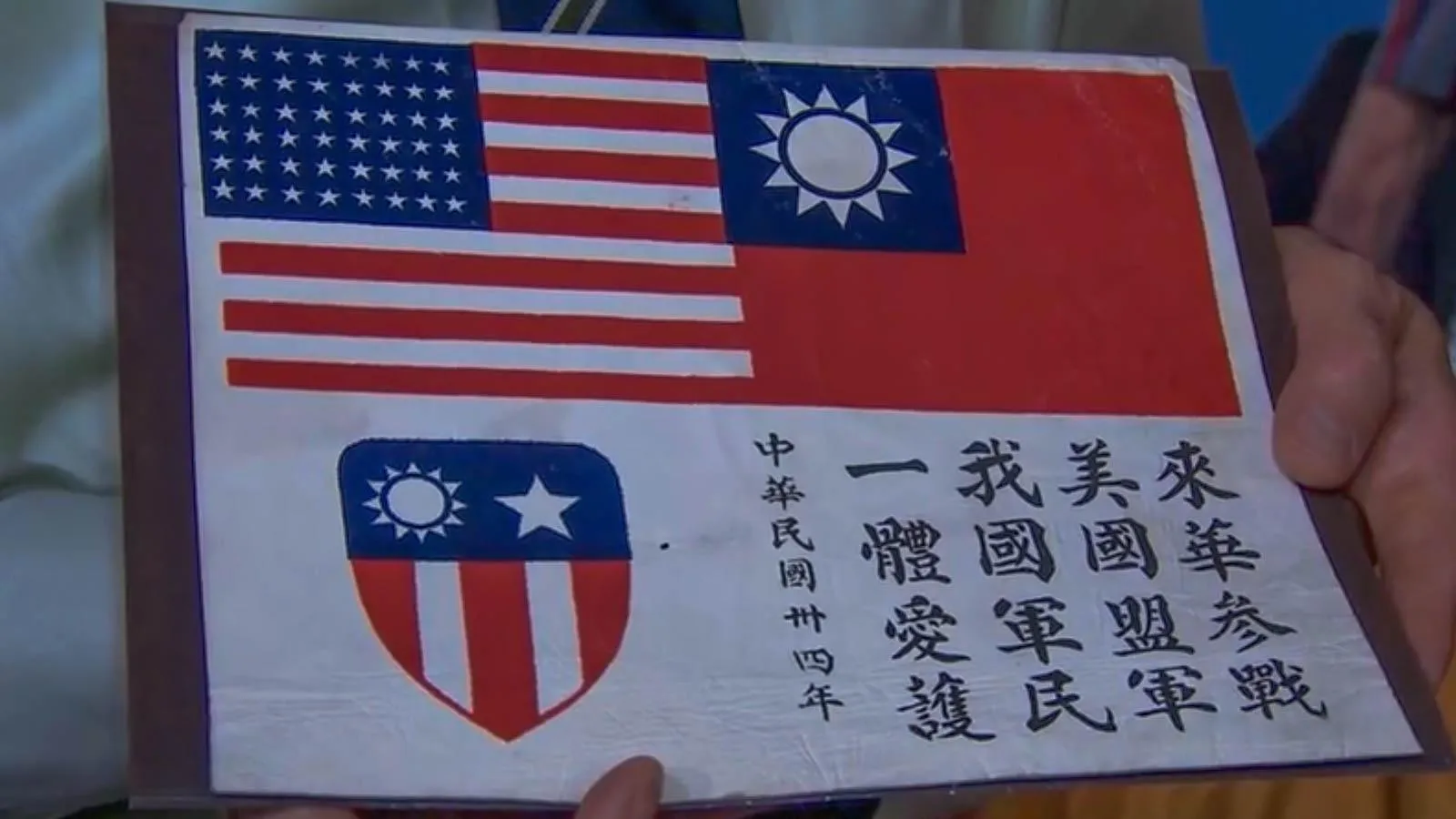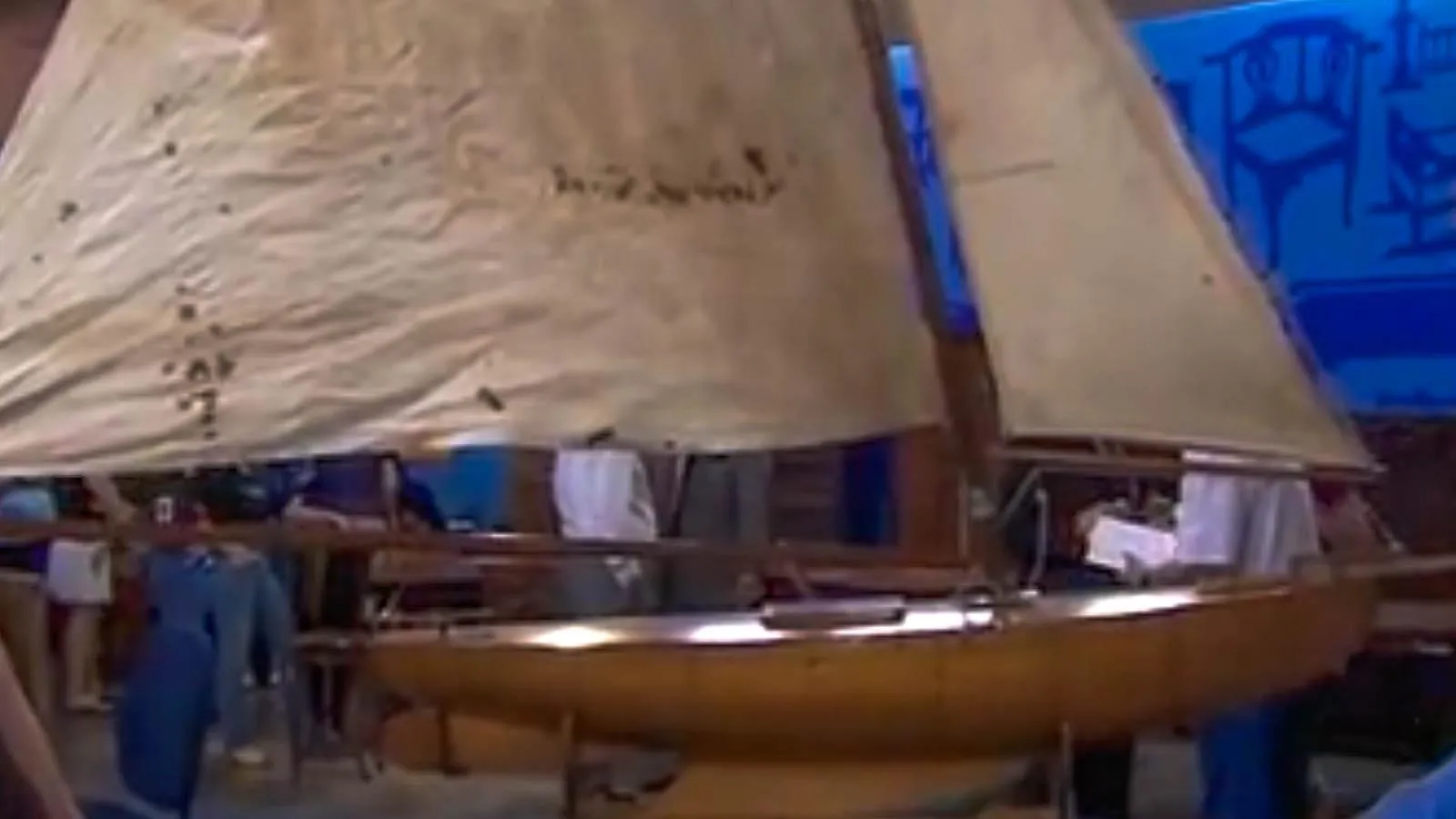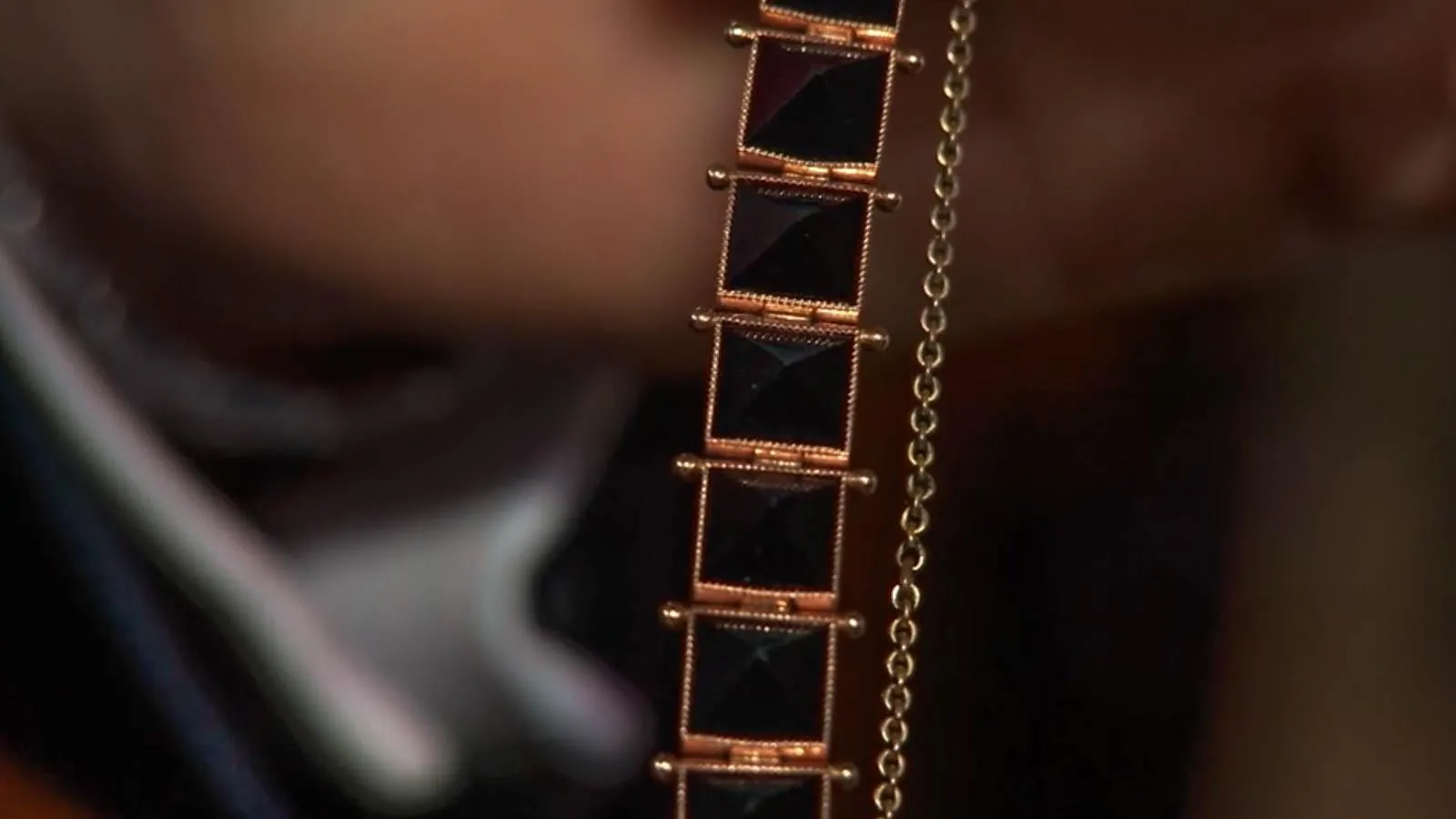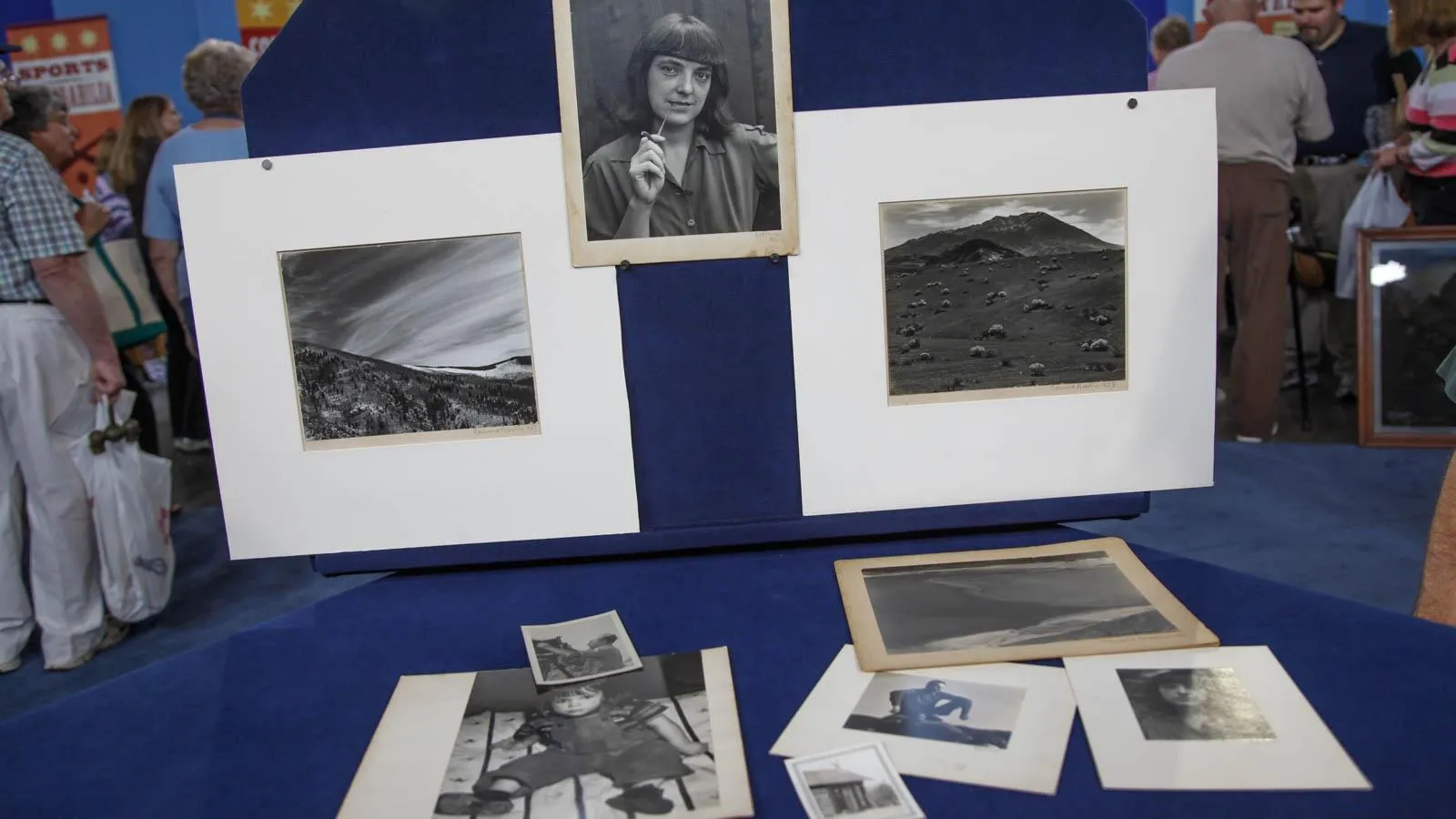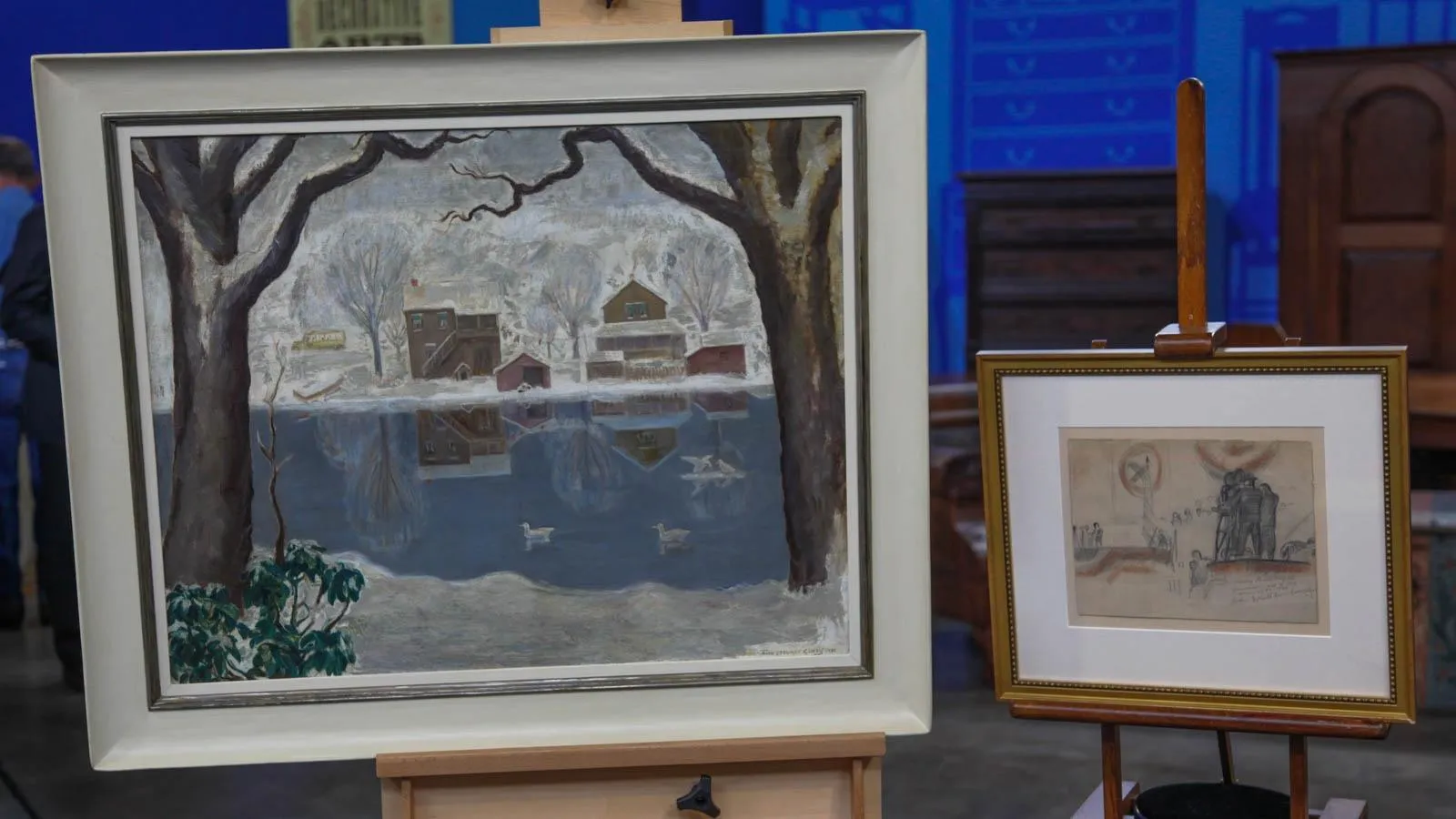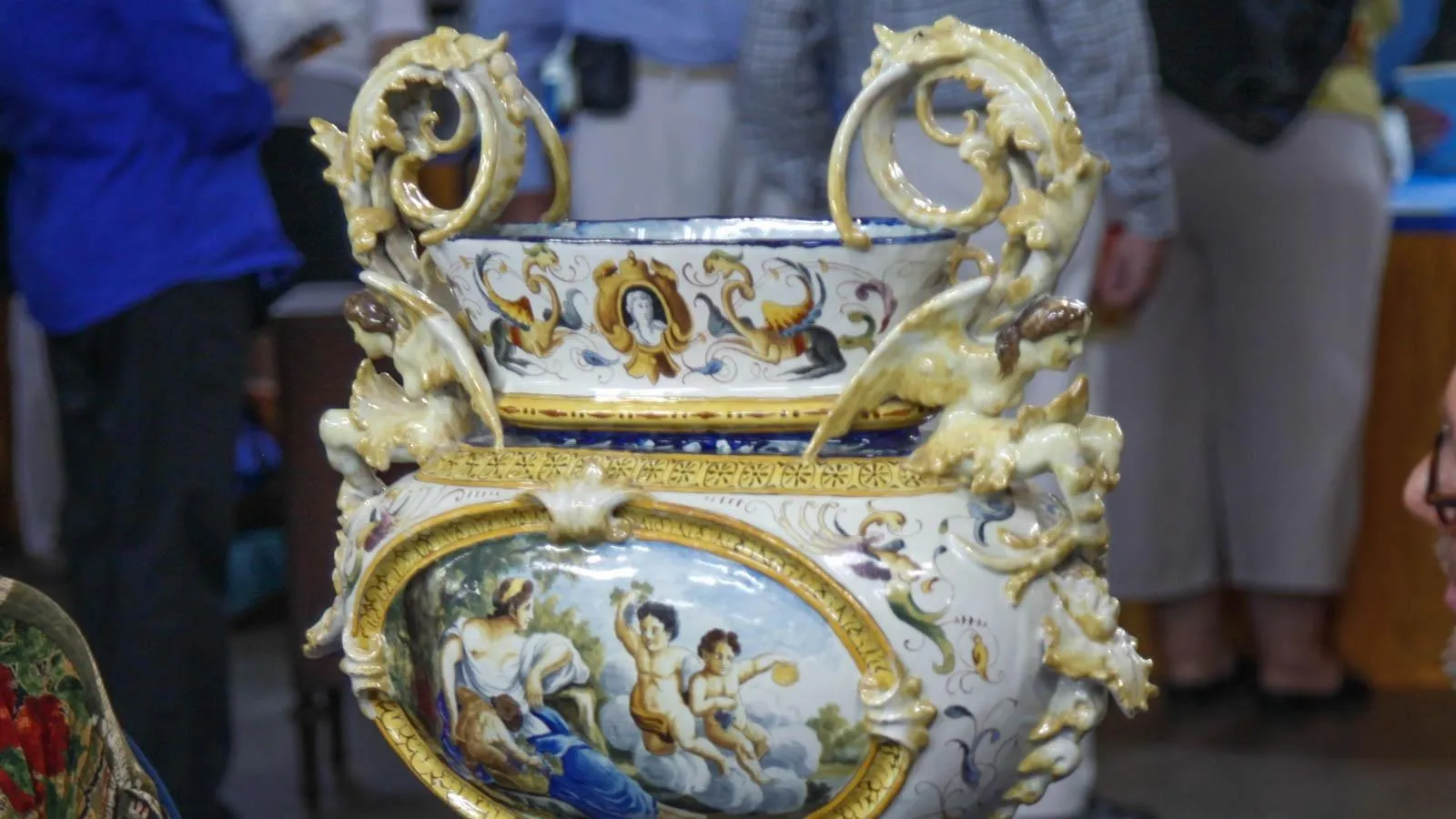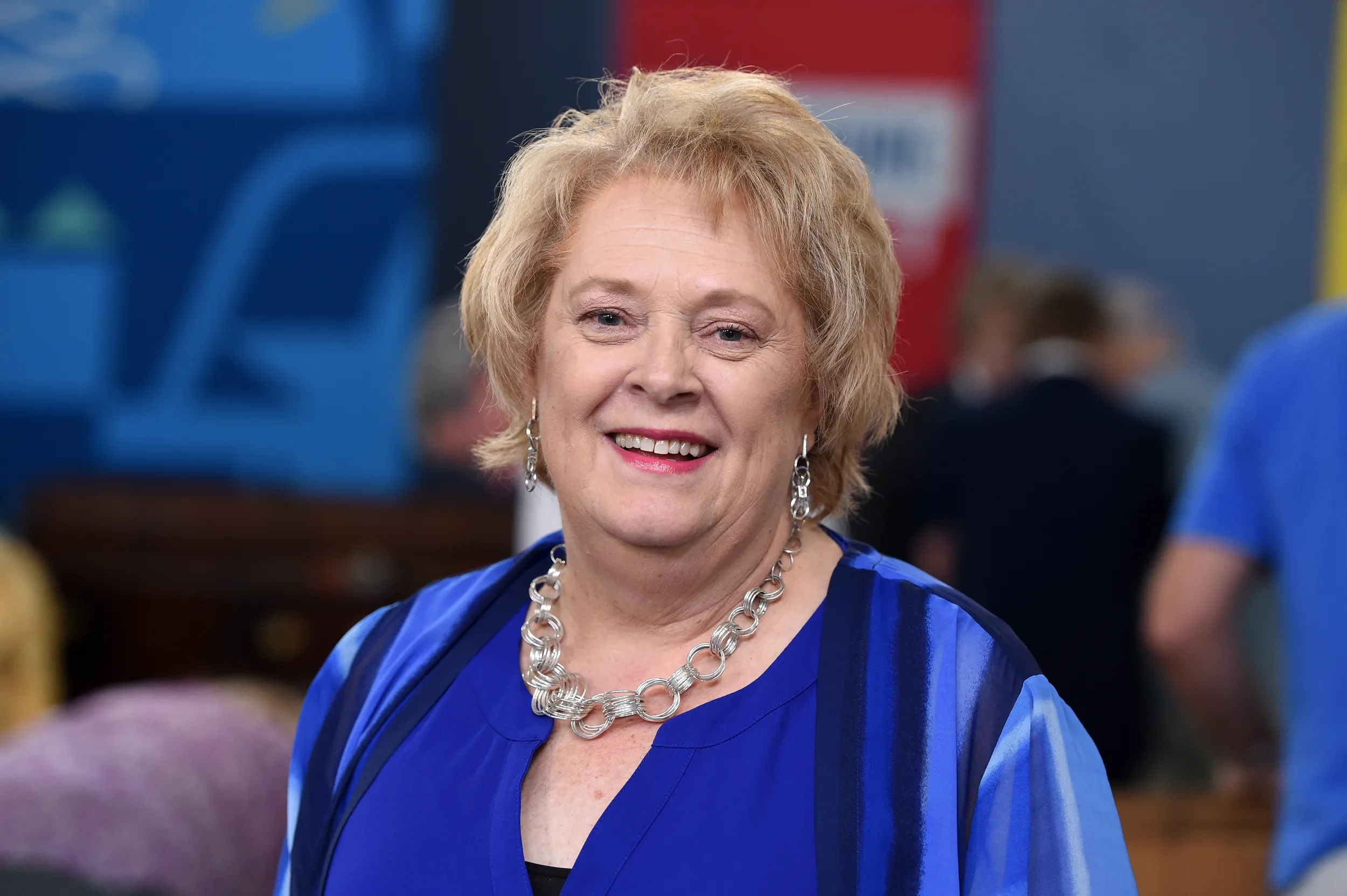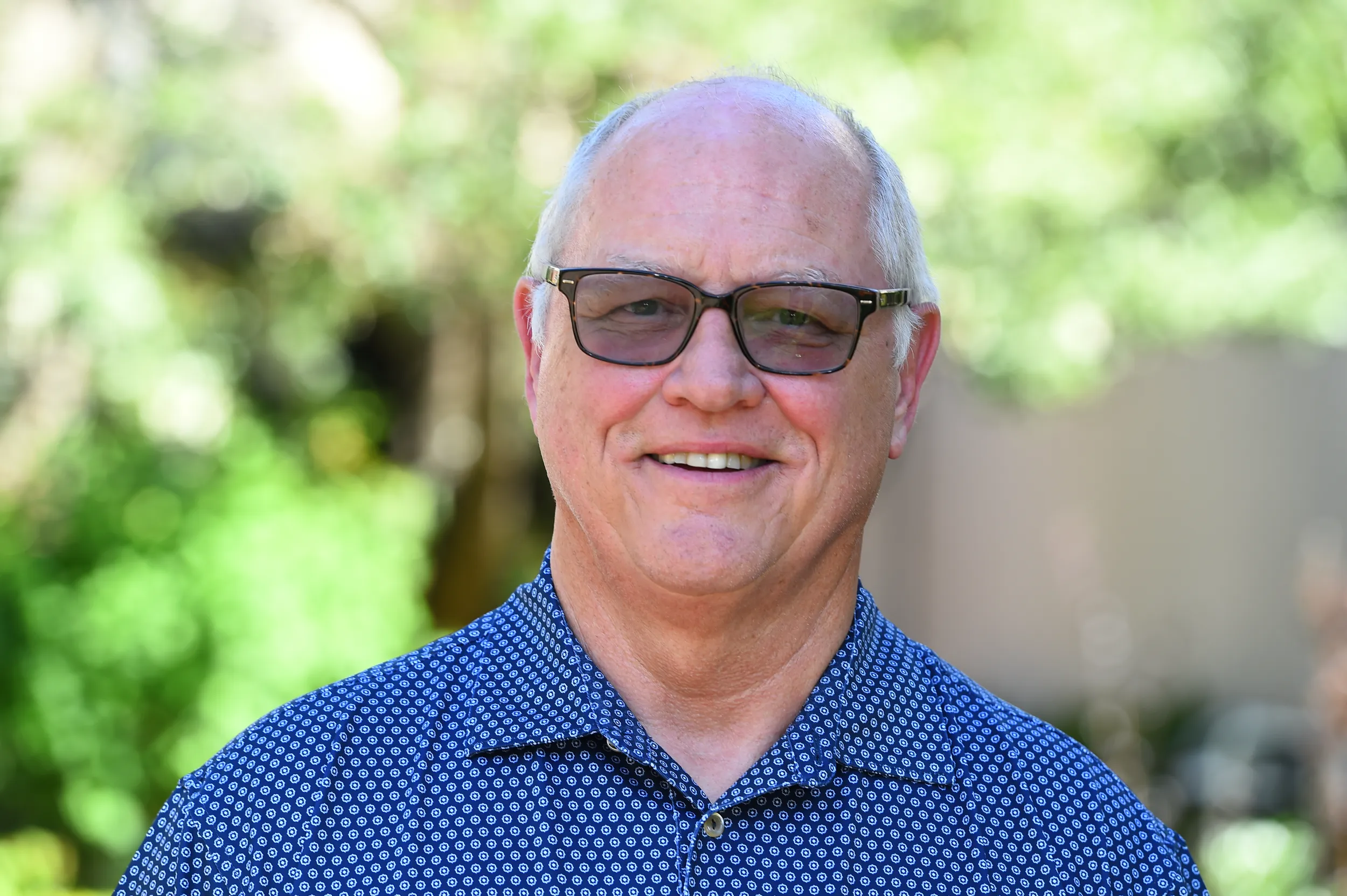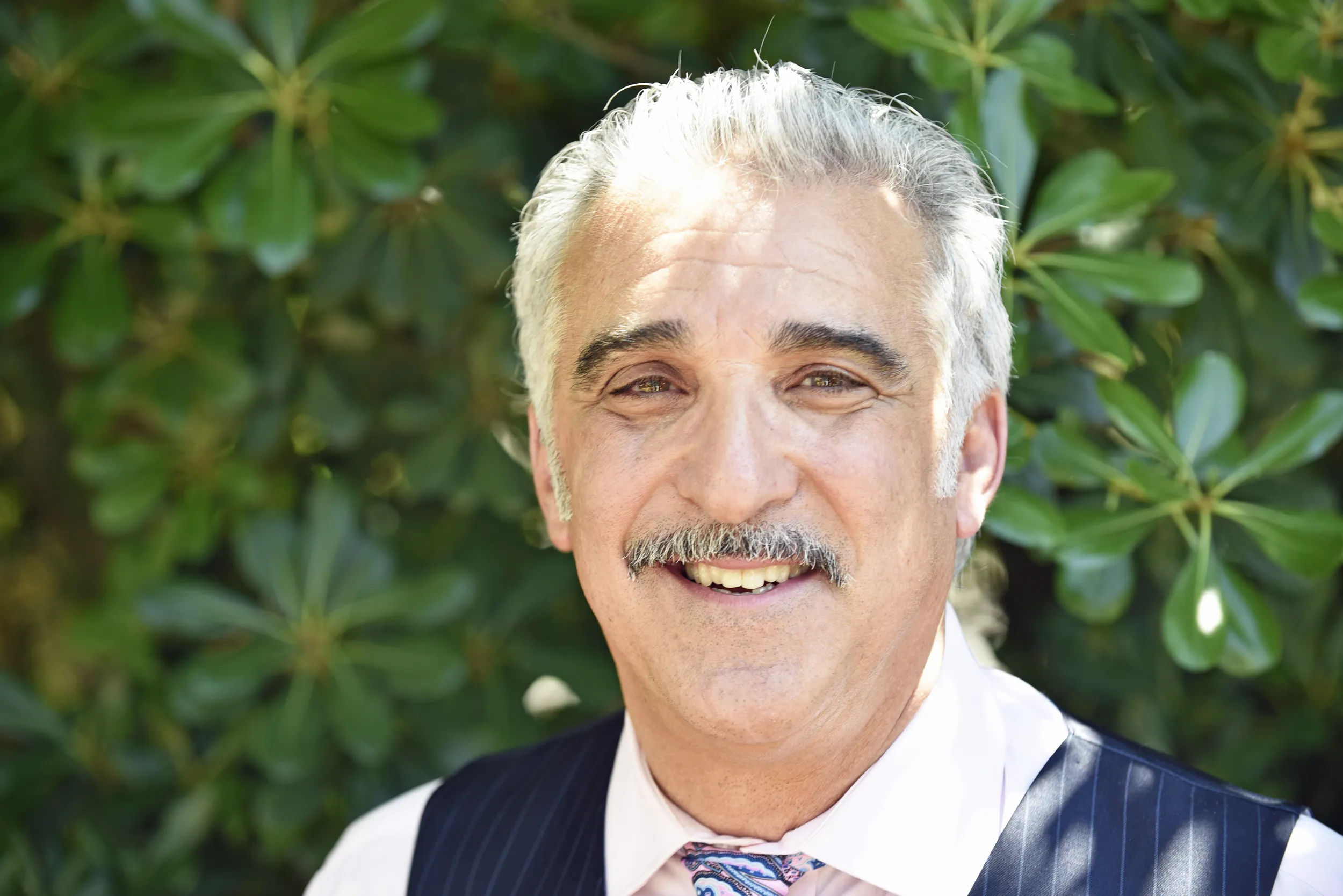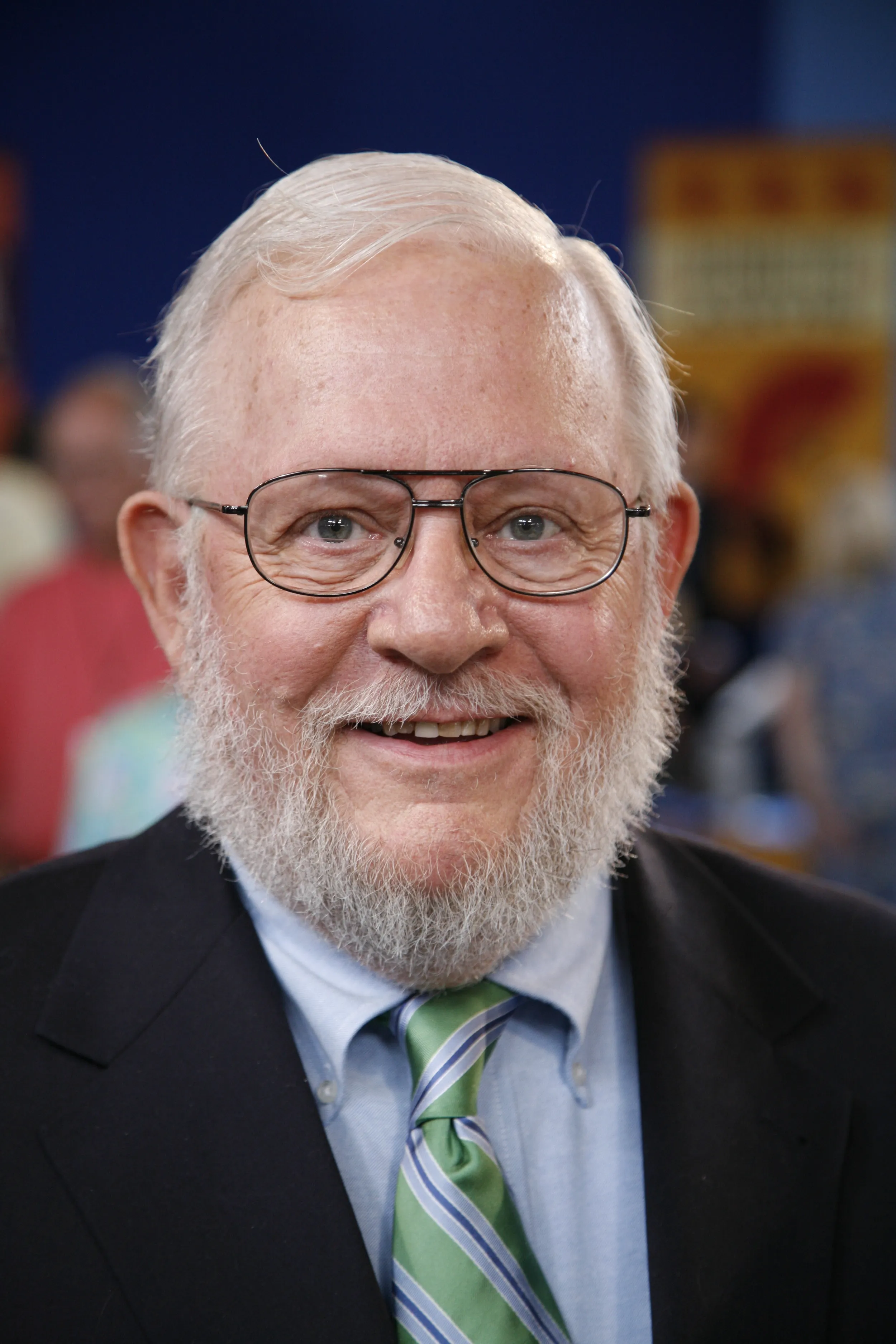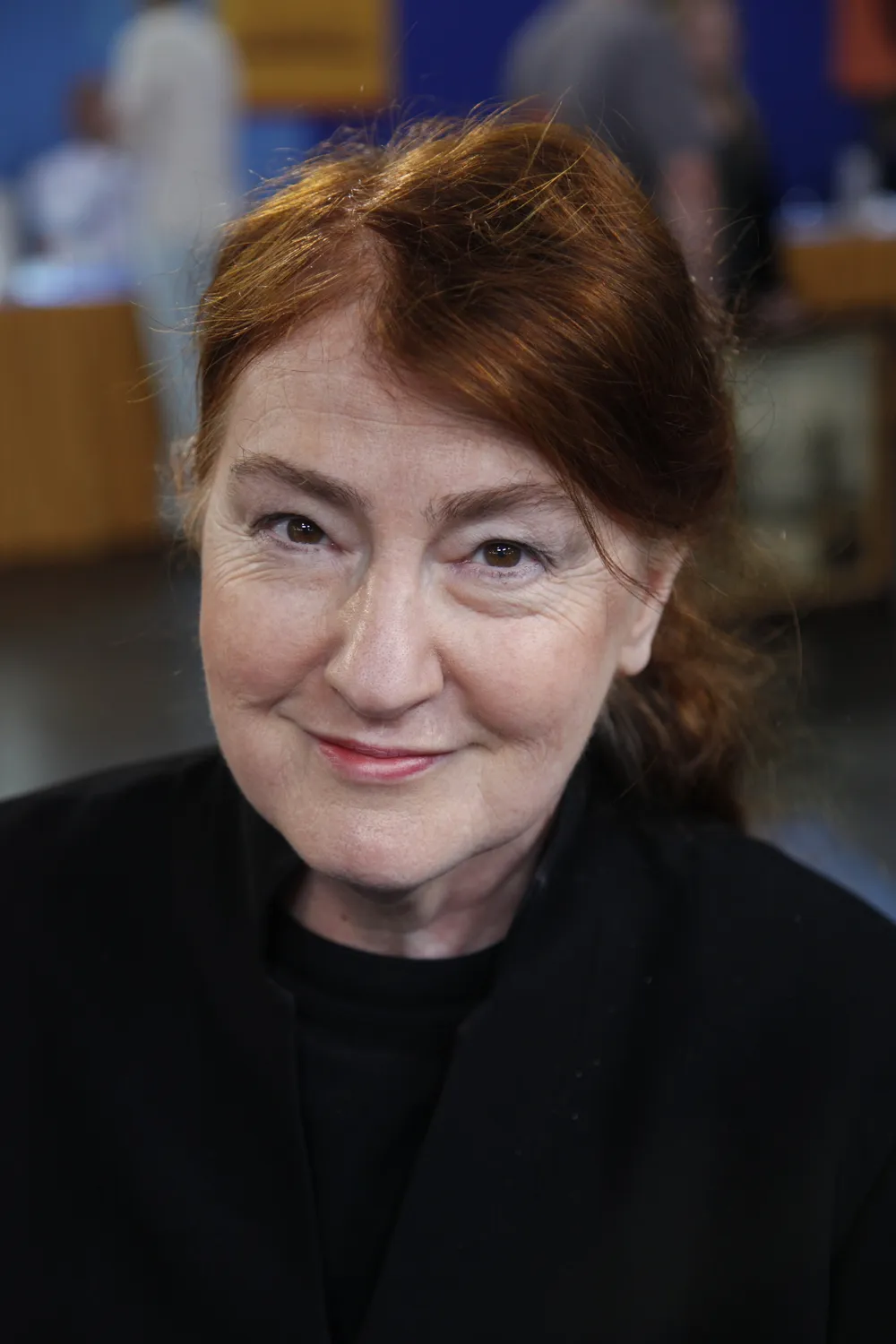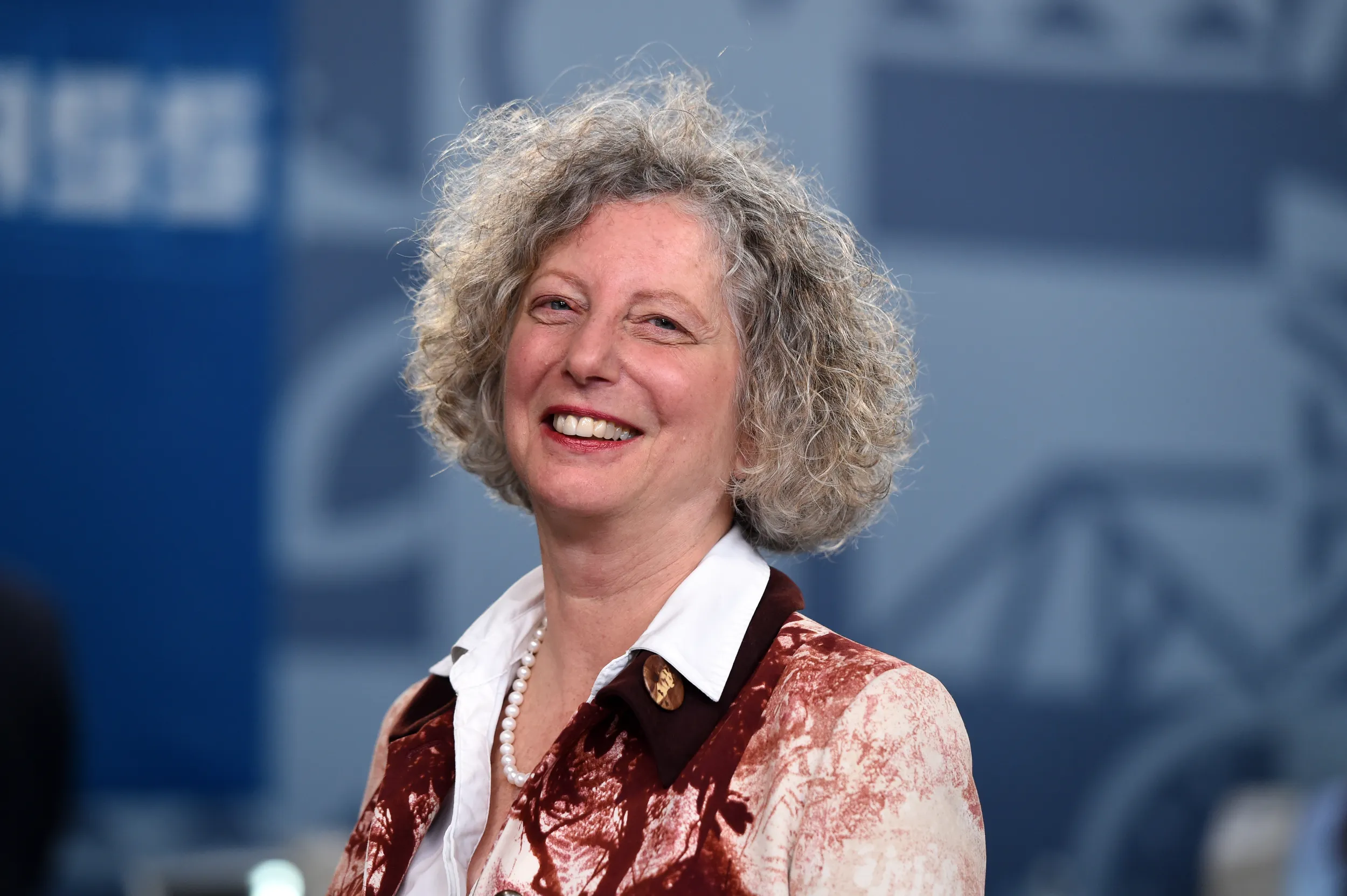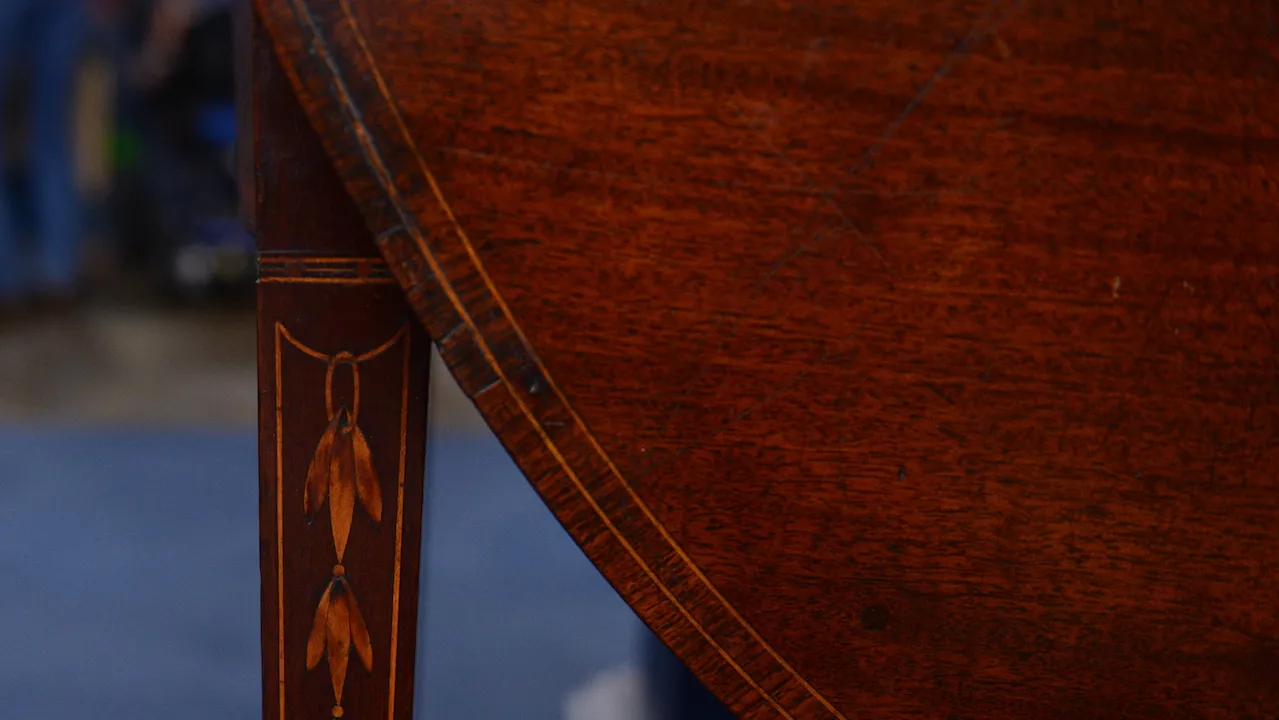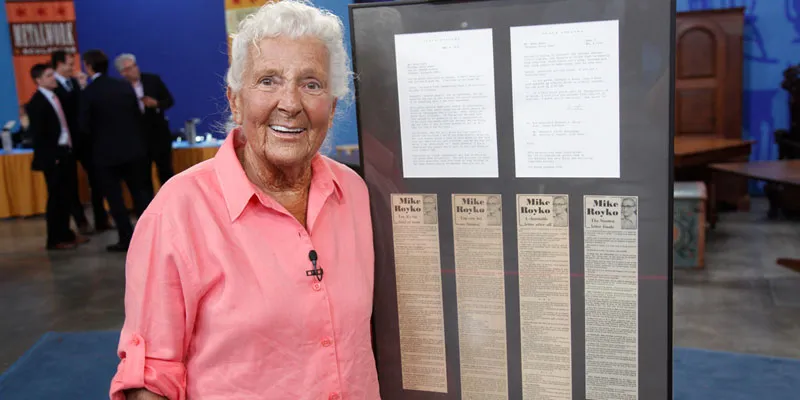APPRAISER: A lot of times people do bring two pieces of jewelry together at a later time.
GUEST: Oh.
APPRAISER: And it's called a marriage.
GUEST: Huh.
APPRAISER: And like all marriages, some are good, and some are bad.
GUEST: Right, okay.
GUEST: Oh my. Oh my!
GUEST: You've got to be kidding.
APPRAISER: No.
HOST: ANTIQUES ROADSHOW’s second visit to Madison, Wisconsin in 2009 produced pieces from across the Midwest...
GUEST: Frank Sinatra was in Chicago to perform. And, of course, all these little ladies on Michigan Avenue were always getting mugged on State Street.
HOST: ...to far beyond the Great Lakes...
APPRAISER: Salopian means "from the county of Shropshire." And I understand it pretty well because I was made in the county of Shropshire, too.
HOST: ...and closer to home.
GUEST: I live on a dairy farm. My husband's family has lived there since 1868. Consequently, there is a one-room school house next to my home. This was one of the pieces that they used in the education of the students.
HOST: How have the values from America's Dairyland aged? Let's "moo"-ve into "Vintage Madison" and see.
GUEST: I always read the Chicago Daily News, and my favorite columnist was Mike Royko. Always for the underdog. Frank Sinatra was in Chicago to perform. And, of course, all these little ladies on Michigan Avenue were always getting mugged on State Street. And Mike Royko wrote a column about the fact that Frank Sinatra had half the Chicago police force acting as his bodyguards on this whole floor of a hotel. And so he wrote a kind of a cute, funny column that, uh, you know, where were all the policemen? Well, they were taking care of "Ol' Blue Eyes." Well, Ol' Blue Eyes didn't appreciate the column and fired off this letter to Mike Royko. So Mike published it in the Daily News and said he would sell that letter to the highest bidder. And the money would go to the Salvation Army. So I decided I'd bid on the letter. And I had a $400 Mother's Day check from my big family. And I was sitting there, and I said, "I'll bid $400." Maybe a couple of weeks later, the phone rang, I picked it up. “This is Mike Royko." (chuckling): I just let out a holler! That was the story of how I got the letter.
APPRAISER: Frank was really ticked off about what Mike said. And so he has, he has a few choice words for Mike. He says, firstly, "Let me start this note by saying, I don't know you, and you don't know me." And he goes on to say, basically, "Where are you coming up with this stuff?” "I don't have cronies." You know, "The police force is being generous. That's not my fault. Why don't you take it up with them?" He says, "Quite frankly, I don't understand why people don't spit in your eye three or four times a day."
GUEST: (chuckles)
APPRAISER: This is Frank talking to Mike here.
GUEST: That sounds like Frank.
APPRAISER: You know, he talks about his tough reputation and that "no one else can prove that type of allegation." (chuckling): And then he calls Mike Royko a pimp.
GUEST: That was...that was the blow.
APPRAISER: And, I mean, this is just amazing stuff. Lastly he says, "I will allow you to pull my 'hairpiece'; if it moves, I will give you another $100,000; if it does not, I punch you in the mouth. How about it?"
GUEST: (laughing)
APPRAISER: He signs it "Sinatra," and then copyrights it so if it's ever published, it has to be published in full. Over here we have Royko's columns, and these two are his responses to Sinatra's letter, where he talks about how he plans on auctioning it off, after he found out that people were interested in the letter, and he wanted the money to go to a good cause, the Salvation Army. I conferred with some of my colleagues here, and we all agree that it is the best Sinatra letter we ever read.
GUEST: Doesn't it sound just like him? (laughs)
APPRAISER: Oh, it's him all the way. I would estimate it at auction at, at least $15,000...
GUEST (gasps): Oh! (chuckling) Oh, no!
APPRAISER: And-and I wouldn't be surprised...
GUEST: Oh, no...
APPRAISER: I wouldn't be surprised if this letter sold for more than that, because Sinatra stuff is-is as hot as it can get, and, uh, and it just doesn't get any better than this.
GUEST (groaning, laughing): Oh!
APPRAISER: So with all the provenance and your great story...
GUEST: Oh, my goodness.
APPRAISER: It's just such a great piece. I was so, so happy that you brought it in today.
GUEST: Oh, gee, I'm gonna faint.
APPRAISER: (chuckles)
GUEST: I'm gonna faint. I really...
APPRAISER: Are you all right?
GUEST: Where are my friends?
CREW: We have seats here.
GUEST: Oh, yes, give me a seat! (laughing) Oh, man! Are they kidding me? Did you all hear that?
CREW: Yes! (chuckling)
GUEST: Did you all hear that?!
CREW: Yes!
GUEST: Oh, isn't that... (laughs) He offered me $100 for it! (laughing)
GUEST: You can't have it for $100! Isn't that super? Aw!
CREW: Yeah, that's so super.
GUEST (quietly): I'm gonna give that money to-- if I ever sell it, the money goes to Salvation Army anyway.
CREW: Oh, that would be good.
GUEST: So the more, the merrier. (laughs)
CREW : There you go.
(laughing)
GUEST: Oh, listen, you just made my...
APPRAISER: Oh..
GUEST: Why-- did you hear that, Betty?
GUEST: I know, I heard it, I heard it, I heard it! (both laughing)
GUEST: These pieces were brought by my grandmother from China in the late 1940s when she went to Germany and then, subsequently, to the United States.
That's a picture of my mother and father on their wedding day. That was taken in 1944.
APPRAISER: When appraising Asian art, we look at three things: firstly, quality; secondly, the material that the item's composed of or carved from; and thirdly, the age. So let's start with the picture frame. This is paneled serpentine carved with quite crude foliate and animal images. If we have a look at these almost comical faces...
GUEST: Mm-hmm.
APPRAISER: ...it's a fair carving.
GUEST: Okay.
APPRAISER: Serpentine is a soft stone; it's porous and shows many inclusions. It doesn't have the purity of a jade. The hardwood is a stained hardwood. The frame probably dates from the end of the 19th century into the early 20th century.
GUEST: Mm-hmm.
APPRAISER: But then we move on to the jade pendant. This is a white jade pendant dating from the 18th century. Its hue or tone is of near pure white.
GUEST: Mmm.
APPRAISER: It's a harder stone, fewer inclusions, if any inclusions at all. There's no big brown or white spurs through the jade. These qilin, or mythical beasts, are carved in a archaic scroll. The archaic scroll frames a immortal figure with script to the reverse. The carving on the pendant is good, not great.
GUEST: Mm-hmm.
APPRAISER: This was worn as a pendant, originally, in the 18th century. And then probably during the late 19th, early 20th century, it was mounted onto a hongmu, or hardwood stand. Which one do you think's worth more money?
GUEST: Well, I assumed, size-wise, the picture frame would be worth much more.
APPRAISER: The serpentine picture frame-- its auction estimate would be between $800 and $1,200.
GUEST: Okay.
APPRAISER: The white jade 18th century pendant, at auction would have a pre-sale estimate of $3,000 to $5,000.
GUEST: Oh, wow. I never would have expected that. That's wonderful.
GUEST: It was my mother's doll. I don't know where she got it. But I've always found it quite fascinating. She was given the doll as a little girl.
APPRAISER: Most of these dolls are 12 inches. This one's 26 inches tall. So it's got to be one of the biggest Plains Indian dolls I have ever seen. Looking at the beadwork and the designs, the way the moccasins are, I suspect it's Cheyenne. Now, whether it's northern or southern, I don't know. But it looks like a Cheyenne
doll from the Plains. It probably dates to the 1870s or '80s.
GUEST(chuckling): Wow.
APPRAISER: This is from the horse culture of the Plains. The horse was...
GUEST: Yeah.
APPRAISER: ...what made them what they were. It changed their entire way of life. Whether it was made for an Indian or non-Indian, it's hard to say because it's completely traditional in the way it's made-- the stitching, the dress, and even the belt is made out of a saddle-tanned leather, which was a preferred belt material. The paint on the face is real unusual. And the hair's missing?
GUEST: I have the hair at home, and it was hair. I mean, you could feel
it was hair.
APPRAISER: Human hair?
GUEST: It might have been horsehair. And it had the beading around the braids.
APPRAISER: I'm glad you kept them. Something's been spilled on it through here.
GUEST: Yeah.
APPRAISER: And I don't know what was on it, but it's...
GUEST: I don't either.
APPRAISER: ...stiffened the hide a little bit. Otherwise, it's in fairly good condition.
It needs the hair put back on it, which, thank goodness, you have. It probably needs the hide worked a little bit by a professional conservator. As it is, if you just
put it up for auction and put the hair with it, it would probably sell for $14,000 to $16,000.
GUEST: (chuckles)
APPRAISER: Now...
GUEST: But I would never sell it (laughs).
APPRAISER: Of course not, it's family. It's part of your family history.
GUEST: I would never sell it.
APPRAISER: It's a French clock. It's not marked, but we know by the style of it that it would have been made in France.
GUEST: Okay.
APPRAISER: It dates from about 1830.
GUEST: Wow.
APPRAISER: Uh, it's a very high-quality clock. This is a representation of the goddess of the hunt. In Roman mythology, that would be Diana. In Greek mythology, it would be Artemis. It also has these other hunt motifs-- the kill here and the hound.
APPRAISER: This is a liqueur decanter set. It opens from the lid pulling up and back. These are the original bottles. We never find these.
GUEST: Well, these ducks have been in my family from the, uh, mid-'30s. I played with them. Our daughter has played with them. And then we finally realized maybe, uh, there was some worth to them besides just being something that, just that we had in the house. And so we put them up aside when we had grandkids. And so the grandkids haven't had a chance to play with them.
APPRAISER: These are very finely made miniatures. And I think they're from
the Illinois River region.
GUEST: Okay.
APPRAISER: And the reason for that is the way that they're painted. And the bills, the way the bills are made. I can't believe you played with them because they're in
such great shape. I think a good starting place, like an auction estimate, is $6,000 to $9,000.
GUEST: (laughing) You got to be kidding.
APPRAISER: No.
GUEST: My parents lived in Bucks County. That's where I was born and raised. And they were interested in George Nakashima's work. So they went and visited him
at his workshop in New Hope, Pennsylvania and talked about commissioning him to make a table. And they wanted a nice, long table...
APPRAISER: Right.
GUEST: ...to fit a lot of people.
APPRAISER: Right.
GUEST: And so this is what George Nakashima...
APPRAISER: Made for them.
GUEST: ...uh, came up with, yes.
APPRAISER: In 1956.
GUEST: '55 or '56. We ate every meal...
APPRAISER: Okay.
GUEST: We had no kitchen table.
APPRAISER: Every mark, every scratch is a record of your family's interaction with it, right?
GUEST: Absolutely.
APPRAISER: George Nakashima, 1905 he was born.
GUEST: Yes.
APPRAISER: And he passed away in 1990.
GUEST: Right.
APPRAISER: His daughter still--Mira, right?
GUEST: Mira.
APPRAISER: Still makes beautiful things.
GUEST: Yeah.
APPRAISER: One of the things that he believed in is that a piece of wood should be used...
GUEST: Used.
APPRAISER: ...and scratched: "Let a piece record the life around it." So that's what you've done. The wonderful thing is this drawing. It shows the two slabs up on top,
and in the center of the picture it says "Sap" in small letters. And you only have four butterfly joints in the picture. Now, he put a total of six, uh, rosewood butterfly joints. And that's really rare in a table.
GUEST: Is it?
APPRAISER: Yes. And he didn't put the sapwood on the inside. He put the sapwood on the outside. So he took these two book-matched boards, flipped them, and on the edge, this is a sapwood, the area just under the bark. That's that beautiful natural, light-colored wood.
GUEST: When my father went into the workshops or the sheds where Nakashima kept his wood...
APPRAISER: Right.
GUEST: ...he asked my father to pick the wood out...
APPRAISER: Oh, isn't that great?
GUEST: ...for this table. He went, and he said, "How about that piece of wood?" And George said, "No, not that one."
APPRAISER: Not that one.
GUEST: "Let's keep looking." So my dad picked another one out, and he said...
APPRAISER: "Not that one."
GUEST: "No, not that one." So my dad finally said, "George, why don't you just pick out a piece of wood."
APPRAISER: You just pick... (laughs) Now, when this table was made, in 1956 or so...
GUEST: Right, that's what we figure.
APPRAISER: ...they were using a lot of hand tools in the shop.
GUEST: Sure.
APPRAISER: And towards the '70s and '80s, when the shop got bigger, they had to use more machine tools, big planers. But this is, it's nice that this is so early. Now, what happened in the Nakashima market is that in the 19 early-'90s things were going for very little, a few thousand per item. And then-- you probably watched
this-- in the late '90s, started going up.
GUEST: Yes.
APPRAISER: And that peaked in about 2006.
GUEST: Okay.
APPRAISER: So it means the market is flooded right now.
GUEST: Yes, okay.
APPRAISER: And this type of table, we would put an estimate, today, of about $25,000 to $30,000 at auction.
GUEST: Okay.
APPRAISER: Now, I could have said, easily, two years ago, a year and a half ago,
$50,000 to $70,000, $50,000 to $60,000.
GUEST: Okay. It's in the family for good.
APPRAISER: He rarely gave the sketches away to a client.
GUEST: Is that right?
APPRAISER: That adds, potentially, a good $5,000 to $6,000, at least, to the table.
GUEST: When my sister and I were packing up our mother's house when she moved to Madison, we found it with some things that had come down through our paternal grandfather. We do know that he had a career in banking. The plaque on the side says that it was given by Prince Albert to a magician named Professor Anderson, who performed at Prince Albert's birthday celebration, I believe in 1849.
Both he and his son, who followed him, toured in the United States and England.
And they periodically had business reversals. So perhaps he left it as collateral for a loan at some point. But, other than that, I have no idea how it got here. I'm not even sure whether it's authentic.
APPRAISER: It is a presentational horn. And based upon what I've seen today, I'm confident that it is authentic. It's actually a Scottish Highland cattle horn. It has been heated and pressed flat. As you can see, there's a shield-shaped plaque
which is applied here, which says, "Presented by Prince Albert to Professor Anderson "in testimony of the prince's approval "of the classical arrangements of the Grand Fête "in conjunction with Professor Anderson's own extraordinary performances on the occasion of Prince Albert's birthday." And then, it's dated
"28th of September, 1849." Interestingly enough, Prince Albert's birthday
was actually August 26. So that may have been the date that he performed, and then it was presented at a later date. In 1849, John Anderson, also known as "Professor Anderson the Magician"-- he was a Scottish magician-- did perform for Prince Albert and Queen Victoria at Balmoral Castle in Scotland. You've got this stone here. It's a natural clear quartz, which has been foil-backed to give it a little bit of a shine. There's a small chip to it, at the base which doesn't affect the value too much. And then, if we spin it one more time, you can also see again, we have a small quartz jewel that's been inset. I suspect that it's either a pewter or a base white metal, I would put an auction estimate of $3,000 to $5,000 on it.
GUEST: Wow, very good.
GUEST: Well, it belonged to my mother. It was bought by my grandfather for my mother. She was in a quartet for a radio station during her teenage years.
APPRAISER: What you've brought me today is a violin that was purchased from Carl Fischer in New York City in 1937.
GUEST: Wow.
APPRAISER: This other documentation shows the correspondence regarding the purchase, that it was purchased on installments. So it must not have been an easy purchase, because it was paid for over time.
GUEST: Yes.
APPRAISER: I think this is particularly humorous, this, this mention of the 46 cents
that was still owed.
GUEST: Yes.
APPRAISER: And then the slightly indignant letter from your grandfather...
GUEST (chuckling): Yes.
APPRAISER: ...saying that he had paid for this and would take care of it in due order. There's a label that's inside this violin that says "Johann Gottlob Heberlein, Neukirchen, 1808."
GUEST: Wow.
APPRAISER: Johann Gottlob Heberlein was a very important maker from the city of
Neukirchen, Germany. Neukirchen has gone on to be one of the most important
violin-making cities in the world. It eventually was named Markneukirchen. And many people who own violins know the city of Markneukirchen. He was very highly
regarded in his time. And this violin was made during his very best period. There's a purity about it that you just don't find very easily. Everything is original, including the neck. Most instruments from this period have a neck that's grafted. This particular instrument has the original neck that's been raised to create the modern neck angle. You almost never, ever see this from this time.
GUEST: Wow.
APPRAISER: The back is a one-piece maple back, as well as the ribs, the neck and the scroll. The belly is made out of spruce. And these are the types of woods that violins were made out of for the last 400 years.
GUEST: Oh, wow.
APPRAISER: The case, I believe, is the original case that it would have been sold in by Carl Fischer. It's very typical of the period of the 1930s. The bow, you can see, has been attacked by bow bugs. They like the protein in the hair, and they like nice, quiet places. So that's why you see all the strands of hair coming down.
GUEST: I see.
APPRAISER: The bow has only one brand on it, which says Germany. It's a nice bow, but it's not particularly valuable. In the retail market, a violin with this kind of purity would sell for $5,000.
GUEST: Wow. Nice. Pretty exciting.
APPRAISER: (chuckles)
GUEST: It's a family heirloom. My great-grandmother, Josephine Davis,
painted it, probably about the turn of the century. She was married in 1888, and I kind of feel that it's probably something she did as an adult.
APPRAISER: This is a pier mirror. And we call it a pier mirror because it's the kind of large, vertical mirror that would have hung in a room in between two windows. And in the 18th century, they used them for light. From the decorative arts period 1880, '90, 1900, the homes are dark. And this brought just a ray of light...
GUEST: Oh!
APPRAISER: ...into a very dark environment. It's a time in American history when women have more leisure, and they're beginning to express themselves through something like this. Now, although she was an amateur, she had a great sense of color. And I absolutely love the way this mirror goes from sort of a dark, somber, moody "lake-scape"-- or riverscape here with the fisherman...
GUEST: Mm-hmm.
APPRAISER: ...up to this wonderful, luminous sky. The sun is setting. It's very cheerful and peaceful. The other thing that's really exciting about it is you can see the foliage has moved across the mirror. If you look at yourself in it, you'd almost be looking through the trees.
GUEST: Yes, yes.
APPRAISER: It's just, it's just wonderful. We see a lot of these painted panels on wood. Women often drew from nature, the aesthetic movement. The important part is that, that it's got its original painted surface. I would say an auction estimate would probably be in the $1,000 to $1,500 range.
GUEST: Okay.
APPRAISER: And it was originally made as a decorative art object.
GUEST: It was. I love it.
GUEST: It's a hand-turn table saw. You have to turn it to saw the board.
APPRAISER: And where did you get it?
GUEST: In 1969, I bought some 40 acres of land. And this table saw was in one of the buildings on that land that I purchased.
APPRAISER: The plaque here is marked "E.F.B. Approved" and it's made by Barnes Tool Company of New Haven, Connecticut. It's actually quite a rare thing. The bad news is that rarity and value don't always go hand in hand.
GUEST: Well, I have son living in London, England and went to visit him, found this little shop and I saw an oil painting. And she said, "An old man just came in a little while ago with some more, signed by the same artist." And I said, "Well, how much for all of them?" And she said, "£50." So it was around $100 for all the paintings: one watercolor and five oils.
APPRAISER: This one is probably Paris. I believe the value to be between $8,000 and $10,000. The Basque pictures, which he was known to have done, can sell for much more.
GUEST: I got it from an uncle of mine that passed away, uh, early '80s. It was part of his estate, and I ended up with it.
APPRAISER: Rockford Watch Company started in 1873.The first thing we notice
about this watch is it-it has the traditional subsidiary second dial down here.
GUEST: Okay.
APPRAISER: But if you notice, there's another dial up top.
GUEST: Yeah.
APPRAISER: It's called an up-down indicator.
GUEST: Oh, okay.
APPRAISER: In modern terminology, it's a power reserve. What it's doing is telling us how much time is left in the spring before it runs out.
GUEST: Oh.
APPRAISER: The movement number is 950. Now that's key; it's a 21-jewel movement. You can see through the back; it's what we call a glazed back.
GUEST: Yeah, I thought that was a neat feature of it.
APPRAISER: But, um, this is a very unusual movement for Rockford. For the most part, they made pretty generic, run-of-the-mill watches, and a lot of them that we see here are worth maybe $100.
GUEST: Oh, okay.
APPRAISER: At auction today, this 950 movement should bring somewhere between $4,000 and $6,000.
GUEST: Oh, really?
APPRAISER: Really.
GUEST: Oh, no kidding.(chuckles)
APPRAISER: All right? So.
GUEST: Oh, that's great.
GUEST: They both belonged to my father's mother, who lived in Austria. She was born in 1896 and unfortunately died very young, um, at 38 years old. She was married to an American diplomat, my grandfather. Had, I think, a little bit sort of more elegant lifestyle because of that than many people at that time would have had. The earrings I inherited in the late 1990s. And, I mean, I like to imagine that they saw balls, and heads of state, and, um, but I really don't know much about their provenance. The ring was also my father's mother's. As I was growing up, it was in my mother's possession. Um, I never saw her wear it. I used to admire it as a child. And a few years ago, she said if I wanted it, I could have it. And so I gratefully accepted her generous offer.
APPRAISER: I was able to find some markings that indicate that, yes, both these items were from Austria.
GUEST: Oh.
APPRAISER: What we have here are a long pair of pendant earrings. They're set throughout with diamonds at the top, mounted in platinum. And then the bottoms here are these large, sort of pear-shaped pearls. The tops, the caps, are actually silver...
GUEST: Oh, okay.
APPRAISER: ...and set with small diamonds as well.
GUEST: Mm-hmm.
APPRAISER: And these are what are called natural pearls.
GUEST: Oh, okay.
APPRAISER: Pearls fall into two categories: either natural or cultured. Cultured means that man intervenes, inserts a bead into the oyster...
GUEST: Mm-hmm.
APPRAISER: ...and the oyster produces the pearl. A natural pearl means that man does not intervene.
GUEST: Oh, okay.
APPRAISER: And an irritant of some sort enters the oyster.
GUEST: Mm-hmm.
APPRAISER: And the oyster starts producing a covering on that irritant, producing a pearl.
GUEST: Okay.
APPRAISER: Now, to get pearls of this size is quite rare when it comes to natural pearls. So, what's unique about these is you have a pair of matched, natural, pear-shaped pearl pendants. A lot of times people do bring two pieces of jewelry together at a later time.
GUEST: Oh.
APPRAISER: And it's called a marriage.
GUEST: Huh.
APPRAISER: And like all marriages, some are good and some are bad.
GUEST: (laughs) Right. Okay.
APPRAISER: Well, in this case, it's a marriage I think that works extremely well.
GUEST: Oh, interesting.
APPRAISER: These bottom pearl pendants actually date from the late 19th century.
GUEST: Oh, they do?
APPRAISER: The tops were created somewhere in the 1920s.
GUEST: Oh, okay.
APPRAISER: So, during the flapper era, when women had short hair, very slinky outfits, these long earrings were very, very much in favor.
GUEST: I see.
APPRAISER: So, chances are, your grandmother, when she had these as just a plain pair of pearl drops...
GUEST: Mm-hmm.
APPRAISER: ...they were probably a little too short. So they were lengthened to create these beautiful Art Deco earrings.
GUEST: Oh, interesting.
APPRAISER: Beautiful ring. Also late 19th century.
GUEST: Mm-hmm.
APPRAISER: Probably 1890s, thereabouts. The ring is constructed from gold and silver and then set with an emerald and diamonds. It's really very typical design of Austrian craftsmanship of this period.
GUEST: Oh, very nice.
APPRAISER: Now, have you ever had these appraised?
GUEST: When I inherited the-the earrings in the 1990s, I got them as part of a lot that included several other items. And the entire lot was valued at $1,500.
APPRAISER: At $1,500?
GUEST: Yes.
APPRAISER: These are worth a great deal more than the $1,500.
GUEST: Oh . Oh! Well, that's nice to hear.
APPRAISER: So, a presale estimate at auction would be anywhere between $18,000 to $22,000.
GUEST: Oh! Oh, my! Wow. (chuckles) That's very unexpected. (chuckles)
APPRAISER: The ring here, which is also quite beautiful, an auction value on this
would be somewhere between $2,000 and $3,000.
GUEST: I see. Wow. Well, that's...that's great news.
GUEST: We had several rugs in my house when I was growing up. This is one of them. The rugs originally came from my paternal grandparents. They were in the house from about 1911 on, when they moved in that house that I grew up in. I think it's about 100 years or more old. It's about trees, and I think it comes from Asia.
APPRAISER: It's actually a Bakshaish carpet from northwest Persia, which is present-day Iran. It's probably about 110 to 120 years old. And the Bakshaish rugs were woven in very small villages by semi-nomadic people. And they always wove these very geometric, very bold, what we normally would call a village rug. It's really more a geometric rug than an urban workshop carpet that you often think of
as the oriental carpet, of something with a lot of very realistic flowers. Whereas here you have very abstract flowers. As you were saying, the tree motif, which many people would call a tree of life, but it's really just the weavers looking at their environment, which was the countryside of Iran. So they were copying that in this very abstracted, stylized manner.
GUEST: I was told, at one point, the little trees-- this one, I think I was told represented a weeping willow.
APPRAISER: Right.
GUEST: And these over here are the cypress-- is that right?
APPRAISER: Exactly. The cypress are the pink hue ones, and then also these red ones.
GUEST: Oh, okay.
APPRAISER: Any vacant area of field that wasn't covered with a tree design was covered with these little stylized human figures, horses, jewelry. And it's really the thing that gives Bakshaish rugs, and other village rugs, their charm. It's what's made them so desired by collectors today. When this rug would have been put in that house, it really would have been considered a secondary or a tertiary rug. It wouldn't have been one of the rugs they thought were very good
or very expensive.
GUEST: Right.
APPRAISER: Uh, and then as markets have shifted, these sort of village rugs have become much more popular. If this was to come up at auction in today's environment, which unfortunately is hurting a little bit, I would expect it to bring
somewhere between $8,000 and $10,000. Whereas, a year ago, year and a half ago...
GUEST: Mm-hmm.
APPRAISER: ...it would have brought closer to the $10,000 to $15,000, maybe even $18,000 range.
GUEST: This is a book called First on the Moon.
APPRAISER: Right.
GUEST: It was a gift from my dad. He bought it in 1970. And starting in 1985,
he worked with Neil Armstrong on a space commission. He had Neil autograph it,
and after that, he followed up and had Michael Collins and Buzz Aldrin autograph it.
And he got an autograph from Arthur C. Clarke, which is on the backside of that page.
APPRAISER: And he wrote the, uh, epilogue, right, to the book?
GUEST: Yes.
APPRAISER: That's fabulous.
GUEST: Yeah.
APPRAISER: I mean, what's so nice about the book is the three inscriptions, as you mentioned. You've got Neil Armstrong, the-the most well-known, and then Buzz Aldrin right there. And then Michael Collins, probably the least well-known of the three.
GUEST: Yes.
APPRAISER: And here's the letter from your father to Michael Collins asking for the book to be signed. And this here is a letter from Neil Armstrong to your dad.
GUEST: Right. My dad was really interested in-in writing a biography of Neil Armstrong, so he had actually approached Neil about writing the biography with him. And, uh, Neil, I think, got that offer quite a bit, and he, at the time, was busy with his company, so he turned my dad down.
APPRAISER: He often did that, we think.
GUEST: Yeah.
APPRAISER: But when there's a connection, like your dad had, it really gives a closeness, a directness of the inscription. It's much more personalized, as you can tell in the letter. And also, what he's written here in the book-- which I think is fabulous-- is, "Richard, one day some Americans will live on the moon. Perhaps you'll be one of them." Which is fabulous. And the book was published in 1970, so it was just the following year after the moon walk.
GUEST: Right after the, the landing.
APPRAISER: When we talk about value, the book itself, uh, without any of the inscriptions, would be pretty nominal. What really is the value is the presentation
and the signatures of the three astronauts. You've got that really nice note to it. And we would auction estimate, the book itself, at, uh, $4,000 to $6,000.
GUEST: Wow.
APPRAISER: The letter here from Neil, we would estimate that at $1,000 to $1,500.
GUEST: Wow.
APPRAISER: I think it's Trevaise, made in 1907 and 1908 in Sandwich, Massachusetts. It was the Alton Manufacturing Company. And they had very Tiffany-esque materials to work with. This leaf-form pattern, iridescent,
is very classically Tiffany-inspired.
GUEST: I bought it in 1961, brand new.
APPRAISER: We've got to look at these pictures, because these are of you.
GUEST: Sure.
APPRAISER: You were a real hipster back then-- 1961.
GUEST: Yeah.
APPRAISER: So you're the original owner of this guitar.
GUEST: Yeah.
APPRAISER: Do you still have the boots?
GUEST: No, they're...they're gone.
APPRAISER: But you still have the hat.
GUEST: The hat, yeah.
APPRAISER: The hat is fantastic. We've got, uh, the original Fender-- --we would call this the "hang tag," but it was actually the instruction booklet. So, you-you were good.
GUEST: Right.
APPRAISER: You held on to that.
GUEST: Right.
APPRAISER: It's got something kind of special in the neck. We call that bird's eye maple. But uh what makes this so great is that it's never been refinished, none of the parts have ever been changed. The pickguard is taking on sort of a greenish color, and all of the control knobs and the pickups are all exactly the same color, fading quite a bit with age.
GUEST: Yeah.
APPRAISER: Have you ever had this uh appraised at all?
GUEST: This one guy, uh, he wanted to give me $2,500 for it.
APPRAISER: Okay. How long ago was that?
GUEST: Uh, about nine years ago.
APPRAISER: Nine years ago, okay.
GUEST: Yeah.
APPRAISER: And do you remember how much you paid for it?
GUEST: Yeah, $350.
APPRAISER: $350. So the present value of a guitar like this, trading on... on the open market, is gonna be about $18,000 to $20,000.
GUEST: Oh, wow. I should have bought two of ‘em.
(laughter)
GUEST: I live on a dairy farm. My husband's family has lived there since 1868. Consequently, there is a one-room schoolhouse next to my home. And several generations of my husband's family attended school there. And this was one
of the pieces that they used in the education of the students.
APPRAISER: This is a very common teaching tool during the early 20th century. These were used in schoolhouses all over the United States to teach the solar system to young people. It has the sun. It has a small planet circling the sun, it has the Earth, and it has the moon circling the Earth. All of these are linked together by gears and chain belts that allow them all to operate together in a consistent fashion to illustrate the motion of the planets and the motion of the moon. This shows the tilt of the Earth and the motion of the moon around the Earth. This is made in Detroit, Michigan, by the Trippensee Planetarium Company. This is the earliest and best example of one of their planetariums that I have seen in a long time. It has the spun-brass sun instead of the plastic one that was put on later. It has all the gearing and drive mechanism, and it even has the brass base with the planetary tables on it. This particular example, because it's so old and in such good condition, is probably worth, $500 to $600. If you sold it in an auction or you had to replace it for insurance purposes, it would probably be more than that. Thank you for bringing it today.
GUEST: Thank you, Phil. This has been great.
GUEST: My grandfather in 1904 joined the Navy to see the world. And he did; he was in Naples, Italy, and he saw the eruption of Mount Vesuvius. He bought this cameo, and he bought several more just like it, and um my mother had them mounted for my sisters and me. 90-some years later, I went to Naples, Italy, and I went to the same jewelry store where my grandfather bought the cameos, and I bought this cameo. And I know this one is made out of lava rock...
APPRAISER: Right.
GUEST: ...hopefully from Mount Vesuvius.
APPRAISER: How did you know where to find the store?
GUEST: My grandfather had the postcard of the-the Bay of Naples, and this store was in it. And I recognized the store from the postcard. It was just lucky that I was there. I think it was meant to be. The man running the store told me that his grandfather carved this, and I realized that it must be related to this one. So I bought this knowing that it was carved by the grandfather about a hundred years before.
APPRAISER: It's a remarkable story. Now, this is the box from the store where you bought the cameo.
GUEST: Right.
APPRAISER: We have this cameo, which is carved out of shell...and then you went
a hundred years later and bought this cameo carved out of lava stone. But this cameo was an antique when you bought it. How much did you pay for it back then?
GUEST: Well, I think it was about $400 or $600, but it was in lira, so I don't...
APPRAISER: Okay.
GUEST: I don't know what I spent, really.
APPRAISER: Anything that's carved up is a cameo. It has to be carved out of one piece of material.
GUEST: Mm-hmm.
APPRAISER: So the one your grandfather bought in 1904 was carved out of a piece
of conch shell. The one that you bought a hundred years later is in the frame,
but made a hundred years ago, and the hardware confirms that.
GUEST: Oh...
APPRAISER: We know that it is an antique one. It is lava-- or at least what they call lava, that is the natural stone; it comes in a lot of colors-- that they dig up from around Vesuvius. It's an easy stone to carve, but it's in what we call high relief.
These materials were not intrinsically valuable. They picked them up on the seashore and dug them up from the ground.
GUEST: Oh, really?
APPRAISER: What was valuable was the craftsmanship. The shell cameo in the gold frame, if it were lost or stolen and you went to buy another one, you would expect to have to pay about $600 or $700.
GUEST: Wow.
APPRAISER: To find one as nice in a gold frame.
GUEST: I didn’t know that.
APPRAISER: Your lava stone cameo, high relief, in wonderful condition, for insurance replacement value, you would need about a thousand dollars to replace that one.
GUEST: Really? I had…
APPRAISER: So your month's rent...
GUEST: (chuckling)
APPRAISER: ...did pretty good.
GUEST: I had no idea.
GUEST: We got it in Massachusetts in late '70s. My husband spotted it at an antique shop.
APPRAISER: Do you recall what you paid for it?
GUEST: I think it was somewhere around $1,200, but honest to goodness, I don't remember.
APPRAISER: You know who the artist is, however.
GUEST: Yes, I do. It's Armin Carl Hansen.
APPRAISER: Right.
GUEST: And he was noted as the Monterey artist.
APPRAISER: He grew up in San Francisco.
GUEST: Okay.
APPRAISER: And his father was a noted artist of Western paintings named Herman Hansen, and he was Armin Carl Hansen's first teacher. Now, he was born in 1886. When he was 20 years old-- that would be 1906-- that was when the great earthquake hit San Francisco. So of course their lives were completely shattered at the time. And the young man, now he's 20 years old, went to Germany to study. He was wildly interested in German Impressionism. And then after doing that for two years, he shipped out on a Norwegian trawler for four years. So he was actually a seaman. When he returned to San Francisco in 1912, he began to paint sailors and fishermen. He also painted Western art, and so he was someone who has two main themes; one is the life of the sea and also cowboys. This is probably from late
19-teens or early 1920s. The people are on the deck, they're being hit by a storm. The waves are washing over the deck and it's a-- particularly nice example of his work. It's an Impressionist brushstroke, but a kind of interesting dark and dramatic palette. A painting like this should sell, at auction, for between $50,000 and $75,000.
GUEST: Oh my. Oh my!
GUEST: My dad was an MP in the 701st MP Battalion in China right after the end of World War II. This was an airman's patch for those airman who flew the Hump from India to China, so that they would be identified as Americans and not Japanese when they were-- if they were shot down.
APPRAISER: This is what is known as a blood chit.
GUEST: Mm-hmm.
APPRAISER: A blood chit was something that was used by airmen so that if they were shot down, the text said, "I am friendly," basically."Take me somewhere safe and you will get a reward." It's something that-- to provide some support for the folks, the indigenous folks, to take the-the pilots and get them home safe.
APPRAISER: What you have here is what we all a pond yacht. What's really nice
about this is, and rare, is to have the original linen sails, all the rigging. It's what we call plank-on-frame construction.
GUEST: Okay.
APPRAISER: Which is the way these boats would've been made original.
GUEST: Actually, I got it from a secondhand shop. I spent $40 on it.
APPRAISER: It's an English bracelet, it was done about 1880, 1890. And it's in 15 karat rose gold. And it's a memento mori piece, so it's actually a piece that was made as a memorial jewelry, for when someone would pass away. If you were looking to replace this, you would have to spend about $800 to $900 to replace it.
GUEST: Really?
APPRAISER: So it's probably not a bad $40 that you spent.
GUEST: No, it's not at all, it's beautiful, it's beautiful.
APPRAISER: It’s brilliant.
GUEST: Thank you so much.
GUEST: This is a picture of my mother; it was taken in 1941 by Edward Weston; he was visiting a school that my father and mother were running, called the
Highlander Folk School. He took three photographs of my mom. This one here, another one which is used as an illustration in the Leaves of Grass by Walt Whitman, and this 4x5 print here. Soon after he left, he gave these other four pictures to my mother, and they've been in the family ever since.
APPRAISER: Well, when we think about Edward Weston, we're talking about one of the greatest photographers of the 20th century, someone who really perfected the art of fine art photography, and in fact was awarded the first Guggenheim fellowship as a photographer in 1937.
GUEST: I didn't know that.
APPRAISER: What Weston used was a large-format, 8x10 inch view camera, and a smaller-format camera that, as we look at these pictures, we see render the images in the finest detail, the highest detail. And he was a master printer in the dark room, so the photographic prints have a warmth and a beautiful tonality that reflects the highest level of photographic expression and aesthetics. They're signed and dated and mounted by Edward Weston, which is the presentation that we hope to see. These pictures are from New Mexico, on the left, and Death Valley on the right. And Death Valley again in the center of the table. Here we see Edward Weston working at the school in Tennessee, which was called the Highlander Folk School. And we get a sense of the artist at work in this photo, but we don't know
who made this photo. The picture of your mom is mounted, and we can see that the mount does have some condition issues along the edges, some browning, some foxing. That photo is initialed by Edward Weston. At auction, if these prints were to be offered as a single lot, my estimate would be $15,000 to $25,000.
GUEST: Okay, I'm impressed.
GUEST: I got them from an antique dealer 50 years ago, or my mother did; I'd gone to this dealer to buy cups and saucers for my mother at her birthday or Christmas or something, and she had this set and she wouldn't sell it. And finally, she called my mother in '51 and said she was ready to part with it. And then my mother gave it to us for Christmas the following year. My mother paid $100 for it.
APPRAISER: Where was this antiques dealer?
GUEST: In Saginaw, Michigan.
APPRAISER: In Saginaw, Michigan.
GUEST: And her husband was a judge, so she got first crack at all the estates up there.
APPRAISER: All the good stuff. I'm going to turn the coffeepot over...
GUEST: Okay.
APPRAISER: ...so we can have a look at what's on the bottom. Tell me what you know about this mark.
GUEST: The mark is Salopian ware. It was made in the McCaughley factories over in England back in the late 1700s.
APPRAISER: There's an English county in the middle of England called Shropshire,
which is also known as Salop. It's an alternate name.
GUEST: Mm-hmm.
APPRAISER: And Salopian means from the county of Shropshire. And I understand it pretty well, because I was made in the county of Shropshire, too.
GUEST: Oh, is that right?
APPRAISER: As a matter of fact, I grew up just, uh, two or three miles
from the old factory where this was made. It was called the Caughley factory.
and some people pronounce it "Cauley," but "Cofflee" is the correct
pronunciation. I've been doing ANTIQUES ROADSHOW now for 14 years, since the very first season, and this is the first piece of Caughley I've seen.
GUEST: Is that right?
APPRAISER: You'll find 18th century English porcelain in general is quite rare. It's a little child's service, and child's services were designed to play with, yes, but also, and perhaps more importantly, to teach young children, young girls in particular, how to behave properly.
GUEST: Oh, is that right?
APPRAISER: Oh, yes. How to look after china and porcelain, how to serve a table and so on. And they were quite in common use, arguably, certainly until World War II. But in the 18th century, you see a few of them. It's hand-painted, which is very sweet. It's painted in the Chinese style, as you'd expect. You've got what are called trios here-- one saucer with a tea bowl and a coffee cup sharing it. Now, this is a common late 18th century presentation. Now, have you ever had it valued?
GUEST: Yes, I did, about... in, uh, the 1970s, we had an appraisal of all our antiques. At that time, he appraised it at $700.
APPRAISER: I think in, in the 1970s, that's a fair price. Caughley is a tiny,
rather insignificant factory. It's heavily romanticized, so it has a good following
in collectors. For insurance valuation, this little group would be valued up to $3,000.
GUEST: Wow, thank you.
APPRAISER: A large part of the value of that is actually in the coffeepot, the coffeepot is one of the sweetest little pieces of Caughley porcelain any collector
could ever wish to have.
APPRAISER: I would've been very disappointed coming to the Midwest and not seeing work by the Regionalist artists. And so I was thrilled when you came in the door with, with these three works.
GUEST: Mm-hm.
APPRAISER: We have John Steuart Curry, we have Grant Wood, and can you perhaps tell me a little bit about how you came by these works?
GUEST: Well, my grandmother went to school with Grant Wood in Iowa and remained his friend. And when she married my grandfather, he came to know Grant Wood, too, and they supported him. They bought several works of art from him in-- earlier in his career. And then when John Steuart Curry became artist-in-residence
at the university here in 1936, they got to know him, too.
APPRAISER: The whole thing about the Regionalists, who flourished in the early 1930s, during the Depression, was that rather than looking to Paris and Modernism
and everything that was going on there, they looked into the heartland. They looked towards American subjects.
GUEST: Mm-hm.
APPRAISER: They would pick farm scenes, there'd be some political paintings.
Subjects would be handled in a humorous way sometimes. Sometimes they were satirical. But the ones that you've brought today are certainly not typical...
GUEST: No.
APPRAISER: ...Regionalist paintings. When one thinks of John Steuart Curry, one might think of "Tornado Over Kansas..." The John Brown--
GUEST: John Brown. (chuckles)
APPRAISER: John Brown-- exactly. Grant Wood, of course, American Gothic.
Great painting that hangs in Chicago. These are a long way from that. This is a very lyrical evocation of a-a river and reflections in a river. And this is a very simple still life of zinnias.
GUEST: Right.
APPRAISER: They are both signed, of course.
GUEST: Right, both done in 1930.
APPRAISER: Yeah, and can you perhaps tell me a little bit about this little one, which is depicting what?
GUEST: The founding of the national Progressive Party by Phil LaFollette here at
the University of Wisconsin.
APPRAISER: Right.
GUEST: It's a drawing inscribed to my grandmother. He gave it to her for a birthday present.
APPRAISER: It's a-- well, it's a wonderful record of that time and of the politics
of that time, and wonderful, too, that it actually happened here in Madison.
GUEST: Here, yeah.
APPRAISER: They're not typical works, but obviously these are major, major American artists, so these will still certainly have some value. The John Steuart Curry, at auction, $25,000 to $40,000.
GUEST: Mm-hm.
APPRAISER: This one, I'm going to say $2,000 to $3,000 at auction. And for the Grant Wood, it's a terrific thing, but a long way from the rolling hills, et cetera, et cetera.
GUEST: Right. Right.
APPRAISER: Which, frankly, have made millions at auction.
GUEST: Mm-hm.
APPRAISER: A painting like this still would make, I would think, quite comfortably $50,000 to $80,000.
GUEST: That's great.
APPRAISER: But it would not surprise me the way the market is going for Grant Wood if it even made more than that.
HOST: You're enjoying ANTIQUES ROADSHOW, Vintage Madison. Want more ROADSHOW? Check out the PBS App. Follow @RoadshowPBS and signup for our newsletter at PBS.org/antiques. It’s the Feedback Booth right after this.
HOST: And now it's time for the ROADSHOW Feedback Booth.
GUEST: Came to the show today with several friends and we had a great time. And we learned a lot of things. Now we're going out back to look for the dumpster.
GUEST: And no one liked my chicken lamp, even though I think it's great.
And it's from my grandma's house.
GUEST: And my beaded bag was worth $350 and it's handmade-- yay!
GUEST: And I got my ducks appraised and, boy, are they all in a row.
GUEST: Dad, your picture is worth twenty bucks. If you clean it up a little bit,
maybe worth $50. (both chuckling)
GUEST: Oh, and as a last-minute thought, Pop, the ring could be $3,000 to $5,000.
GUEST: And the best part is, we got to meet one of the Keno brothers. Which one was it?
GUEST: The cute one.
GUEST: Turns out, with all of our great stuff, my Hawaiian beer shirt has more
value than any of it.
GUEST: So this is an Epiphone sensory guitar that I bought at a yard sale for ten dollars, plus the amp. And I should insure it for at least $1,500.
GUEST: Play us a little ditty, Mark!
GUEST: (strums) Thank you, ANTIQUES ROADSHOW.
GUEST: This is a Ming dynasty pot, but it's, uh, fake.
GUEST: It's a fake.
GUEST: It's a fake.
GUEST: Um.
GUEST: If we had a dollar for every compliment that we got here today, it would be more than what it was appraised for.
GUEST: I got this picture from a garage sale for ten cents, and it's worth a quarter! ANTIQUES ROADSHOW, you rock!
HOST: Thanks for watching! See you next time on ANTIQUES ROADSHOW.

